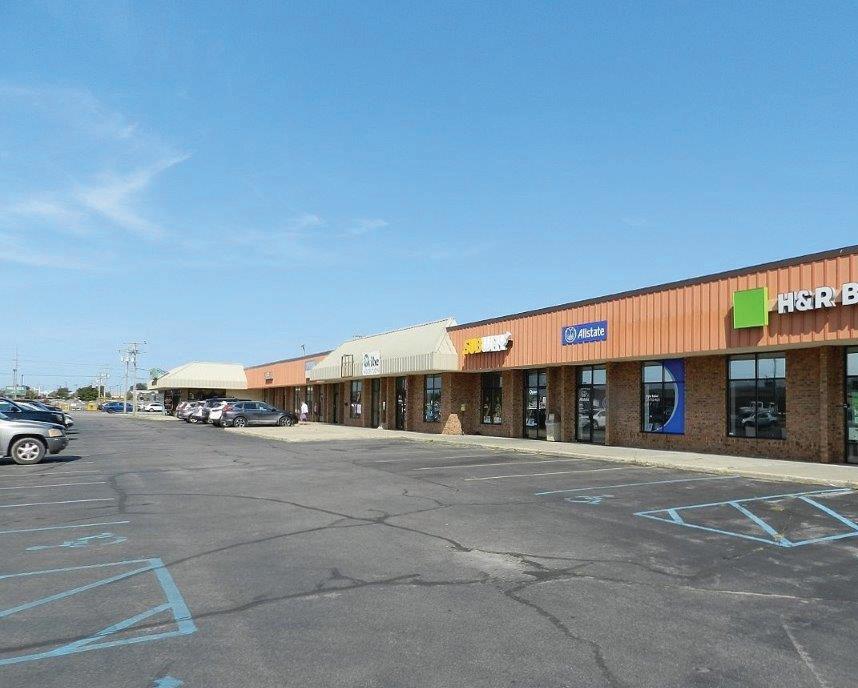




Inside the complex equation Munson faces as it recruits physicians to northern Michigan






Office 5931 Oakland Drive Portage, MI 49024 269-385-5888 or 888-777-0216
• We uphold a Fiduciary Standard and work with clients on a fee-only basis.
• We do not receive commissions, kick-backs, or soft dollars from product sales, eliminating inherent conflicts of interest.
• Our team of professionals holds designations and degrees such as CFP®, CFA, CPA, MBA, JD, and PhD.
• Charles received his MBA from the Kellogg School of Management - Northwestern University, his MA in Economics from WMU, and Executive Education from Harvard Business School and Columbia University.
• Ranked #1 on Barron’s list of America’s TOP Independent Advisors for 2025. Charles has achieved the #1 ranking four times within the past five years.*
• Ranked #4 in the nation on Forbes’ list of TOP Wealth Advisors and is the highest-ranking Fee-Only Advisor on the list.*
Minimum investment: $1,000,000 in Michigan/$2,000,000 outside of Michigan. Assets under custody of LPL Financial and Charles Schwab.


Pets Naturally and The DOG Bakery by Pets Naturally in Traverse City, founded by Kathy Hyland 12 years ago, is now under the ownership of Hyland’s daughter, Jessica Follett. Hyland started Pets Naturally - which specializes in natural food and wellness products - to help her dog at the time, who was facing ongoing health challenges. “I am absolutely thrilled to have Jessica continue the legacy of Pets Naturally and The DOG Bakery by Pets Naturally,” said Hyland. “Jessica’s passion for animals, paired with her fresh vision, will guide these businesses into the future.” Pets Naturally is located at 1117 South Airport Rd.
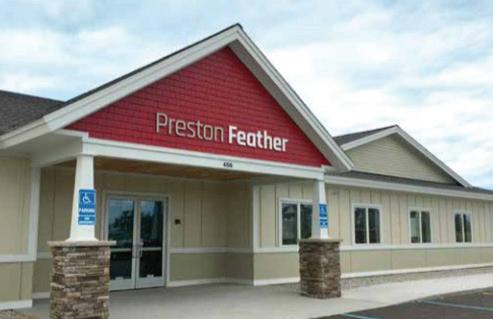
Preston Feather Building Centers, with a location in Traverse City, has acquired Barden Lumber, a Boyne Citybased supplier that has served contractors and homeowners since 1922. Together, the companies bring more than 200 years of combined experience, relationships and regional commitment to the building industry. “This isn’t about replacing a legacy, it’s about carrying it forward,” said Rachel Huntman, president and owner of Preston Feather, a family-owned company founded in 1915. As part of its continued investment in northern Michigan, Preston Feather is also doubling its operations in Traverse City with a new 30,000 squarefoot distribution and logistics facility. This addition will strengthen supply chains and enhance service capabilities. Preston Feather also has locations in Gaylord, Harbor Springs, and Petoskey.
20Fathoms and Venture North in Traverse City recently announced the recipients of $72,000 in small business grants. Each of the following businesses received approximately $4,500: Betsie Riverside Resort LLC (Benzonia); J.bird Provisions (Charlevoix); Tiny Traveling Boutique (Elk Rapids); Mud Puppy, LLC (Harbor Springs); Little Big (Harbor Springs); Bear Earth Herbals (Kingsley); The Hidden Maker (Lake Ann); The Grove Beverage Cafe LLC (Petoskey); Removed Waste (Petoskey); Sweet Frond Farm (Rapid City); Back Pocket Music (Traverse City); Fable & Fen, LLC (Traverse City); Cultured Kombucha Co. (Traverse City);TC Millworks (Traverse City); MiddleCoast Brewing Co. (Traverse City); and Lakeview Hill Organic Farm (Traverse City). The businesses were selected based on their company’s strategic need for funds, as well as the expected impact on their community. Applications were reviewed by a committee of small business support professionals representing Northern Lakes Economic Alliance, Grow Benzie, and 20Fathoms

The former Mammoth Distilling space next to The Workshop Brewing Company in Traverse City’s Warehouse District will be home to new restaurant The Three Pigs. Owner Chad Perreault said renovations will begin this month ahead of a targeted February opening. Perreault previously operated the Heart n Seoul food truck at Earthern Ales. The Three Pigs – a nod to Perreault’s three brothers as well as samgyeopsal, the Korean word for pork belly that translates to “three-layered meat” – will bring the chef’s favorite communal dining tradition to Traverse City. While traditional Korean BBQ typically sees customers grill marinated meats at their own tables, Perreault says restaurant staff will grill the meat in the back of the house and then bring the grill arrangement out to customers. That’s to help acclimate diners to the tradition, he adds, with the goal of eventually transitioning to customers cooking the meat themselves. The Three Pigs will also feature karaoke rooms and a photo booth, both staples of Korean culture.









































TCLP fiber , Traverse City Light & Power’s community broadband division, has been named to the 2025 Broadband Communities Top 100 list. This recognition highlights TCLP fiber among a select group of companies, entities, and organizations making the most significant impact on broadband advancement nationwide. “We’re thrilled to see TCLPfiber recognized on this year’s Top 100 list,” said Scott Menhart, chief technology information officer of TCLP. “This achievement reflects the dedication of our team and the vision of our community to expand access to reliable, high-speed internet. It’s a testament to what local utilities can achieve when we prioritize connectivity as an essential service.”

Munson Healthcare recently announced plans to construct a new 22,000 square-foot, 24-bed neonatal intensive care unit (NICU) at Munson Medical Center (MMC) in Traverse City. The project, slated to begin in the spring, is part of a $40 million investment in women’s and children’s services that also includes renovation of the maternity and pediatric units at MMC. The targeted opening date for the new NICU – which will be connected to Munson and located between the hospital and the Cowell Family Cancer Center – is late 2027. Munson is home to the only NICU in northern Michigan, and provides care to more than 325 babies each year from across the region.
The Grand Traverse Regional Community Foundation has awarded $334,700 in Community Funds grants to 14 organizations – out of 111 requests –across Antrim, Benzie, Grand Traverse, Kalkaska and Leelanau counties, and the Grand Traverse Band of Ottawa and Chippewa Indians. Community Funds grants offer flexible support for local organizations working in the areas of greatest need. The Community Foundation awarded grants this cycle to: Goodwill Industries of Northern Michigan, Child & Family Services of Northwestern Michigan, Northwest Michigan Support-
ive Housing, Father Fred Foundation, ROCK of Kingsley Youth Center, Traverse Bay Children’s Advocacy Center, Frankfort Community Land Trust, Grass River Natural Area, Michael’s Place, Habitat for Humanity Grand Traverse Region, Women’s Resource Center for the Grand Traverse Area, Microcenter Child Care Network, Acme Christian Thrift Store and Food Pantry and Grand Traverse Industries.

GALLERY RELOCATES TO TC
Laughing Fish Gallery, a mother-daughter art studio known for its handmade creations, has relocated from Suttons Bay to a new space in The Village at Grand Traverse Commons in Traverse City. The gallery continues to feature the whimsical wood-carved fish, prints & cards, weavings and other colorful works crafted by Shelly and Kirstie Drews. The new location also introduces an Art Café, where guests can drop in or reserve a table to paint their own wooden art projects; LaughingFishmi.com
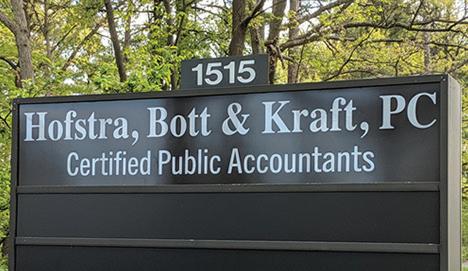
Hofstra, Bott & Kraft, P.C. (HBK), a certified public accounting firm in Traverse City, has merged with Andrews Hooper Pavlik PLC (AHP). The expansion into Traverse City increases the number of AHP offices to 11, with locations throughout Michigan and more than 180 team members. All HBK team members in the Traverse City office will continue to operate from the location at 1515 Cass St. “Merging with AHP provides HBK with much needed capacity to service our clients along with greater strengths in the areas of administration, technology and research,” said HBK partners Chris Bott, CPA and John Kraft, CPA. “Our firms have similar operating philosophies, and we will continue to provide the personal service that we have provided in the past.” AHP also has offices in Ann Arbor, Bay City, Bloomfield Hills, Flint, Grand Rapids, Marquette, Midland, Okemos, Owosso and Saginaw.
15% of your purchase at participating downtown shops goes to a local nonpro t of your choice.

5 bedroom 3 bath home with primary floor bedroom and unobstructed and endless East Bay and Peninsula views overlooking farms and orchards. The beach club just down the way hugs one of the most idyllic shores of East Bay along Bluff Road, literally a site out of magazines and commercials. Located in the coveted Bluffs community with access to trails, tennis courts, beach club and a natural private view lot.










There are many successful businesses in northern Michigan that are strongly committed to doing good for the community and the environment.
One family in Benzie County – representing two unique businesses and four generations – is a great example of how doing good for the community and doing good for business aren’t just compatible, but are mutually reinforcing. They demonstrate the “Power of And.”
Watervale Inn is a historic, family-owned summer resort on the shores of Lower Herring Lake and Lake Michigan that has been welcoming guests for 108 years. The Kraft/ Noble family is the ownership family; Jennie Turner Schmitt, a fourth-generation member, is the current operator.
Stormcloud Brewing Company, founded by Jennie’s husband Rick Schmitt has been serving Belgian-inspired craft beer since 2013 in downtown Frankfort. Together, Rick and Jennie have impacted our small corner of northern Michigan.
The gift of Watervale
For more than a century, Watervale Inn has been a destination for exceptional hospitality, and it holds a special place in my heart. As a child, Watervale’s beaches were part of my summer playground. More recently, we celebrated Mother’s Day dinners with our moms, who loved every detail – fresh spring flower arrangements on each table, starched tablecloths and napkins, delicious cuisine and connecting with dear friends. My sister exchanged wedding vows on the deck overlooking Lower Herring Lake. We also have a special connection with Stormcloud Brewing Co. Rick Schmitt joined Crystal Mountain as our director
EDITORIAL & BUSINESS OFFICE
P.O. Box 4020 Traverse City, MI 49685 231-947-8787
ON THE WEB
tcbusinessnews.com
PUBLISHER
Luke W. Haase
lhaase@tcbusinessnews.com
CONTRIBUTING EDITOR
Gayle Neu
gneu@tcbusinessnews.com
HEAD WRITER
Craig Manning
STAFF WRITER
Art Bukowski
COMMENTARY BY CHRIS MACINNES
How four generations are building community and business success in northern Michigan
of sales and then vice president of sales and marketing in 1995, relocating from Denver with his wife, Jennie Turner Schmitt. This move also helped Watervale transition to the next generation of family-operated leadership, with Jennie becoming general manager.
It all began in 1916 when Dr. Oscar H. Kraft, a Chicago ophthalmologist, purchased the abandoned lumber town of Watervale, established in 1892. His vision was to create an idyllic summer place for family and friends, but in 1917 he opened it as a resort.
In 1960, Dr. Kraft sold the resort to his niece Vera Noble and her husband Vern. They ran it until the early 1980s when they transferred ownership to their children with their daughter, Dori Noble Turner, taking over as the innkeeper.
Not only did Dori carry on Watervale’s tradition of simple elegance and exceptional hospitality, but also the “Power of And.” Dori led the family’s decision to permanently protect more than a mile of beautiful Lake Michigan shoreline with a conservation easement to the Grand Traverse Regional Land Conservancy.
This huge gift was key to the Conservancy’s acquisition of 2,800 acres bordering Watervale, now the Arcadia Dunes C.S. Mott Nature Preserve. This preserve not only enhanced Watervale’s guest experience but also provided public access to a spectacular natural area with trails, Lake Michigan beaches and stunning views. The family then helped to protect another 420 acres and nearly four miles of shoreline across the Upper Herring Lake and Green Point Dunes Nature Preserves.
In 2003, Jennie, alongside her mother, carried on the family legacy of steward-
CREATIVE DIRECTOR
Kyra Cross Poehlman
CONTRIBUTING WRITERS
Ross Boissoneau
Kierstin Gunsberg Rick Haglund
COPY EDITOR Becky Kalajian
WEB PRODUCTION: Byte Productions
MAILING/FULFILLMENT
Village Press
DISTRIBUTION
Marc Morris
SERVING
Grand Traverse, Kalkaska, Leelanau and Benzie counties
ship, placing an historic conservation easement on the original Victorian-era buildings to ensure that the resort’s timeless character would be preserved in perpetuity.
Authenticity of place, a mecca for outdoor recreation and gracious hospitality are all reasons why Watervale guests return year after year, for generations. But Glen Chown, CEO of the Grand Traverse Regional Land Conservancy adds another reason.
“It’s a feeling of being part of a community that cares for the people and the places that make its success possible, and where benefits are shared,” he said.
Stormcloud rolls in
In 2012, Rick left Crystal Mountain to start Stormcloud with his partner Brian Confer. We were sad to lose a valued leader, but we knew this business would incorporate the “Power of And,” contributing to the common good and growing a sustainable business.
Stormcloud quickly became a regional favorite, earning recognition as Best New Brewery in Michigan by the MLive Media Group within three years. It brought 75 new jobs to Frankfort and new life to the city as a year-round gathering place for neighbors and visitors, with activities like curling, bocce ball, Trivia Night and community partnership such as “Keep Benzie BeautifulLakeshore Cleanup.”
In 2017 Stormcloud added a second facility, increasing its brewing capacity and employee base, and it included many eco-friendly features, such as onsite solar arrays, energy-efficient heating and cooling, and a waste reduction process that sends spent grain to local farmers for livestock feed.
AD SALES
Lisa Gillespie lisa@northernexpress.com
Kim Murray kmurray@tcbusinessnews.com
Kaitlyn Nance knance@northernexpress.com
Abby Walton Porter aporter@northernexpress.com
Michele Young myoung@tcbusinessnews.com
The “Power of And” in action
Beyond the brewery, Rick’s contributions to the common good are worth noting. He and Jennie, along with Marci and Blake Brooks, saved the historic Garden Theater from demolition in 2008. The theater, a community anchor since 1924, had fallen into disrepair in early 2000. If it wasn’t for believing in the “Power of And” and creating the Friends of the Garden Theater, the space wouldn’t be the vibrant hub it is today with movies, music, concerts, community fundraisers, irresistible popcorn and the Frankfort Film Festival.
Rick and Jennie are both civic leaders. Rick served as president of Frankfort Elberta Schools for 12 years and is the current chair of Frankfort’s Downtown Development Authority. Jennie is the president of the Benzie Shores District Library and serves on the Board of Michigan Legacy Art Park, which is close to our hearts at Crystal Mountain.
Enterprises like Watervale Resort and Stormcloud Brewing Company, led by people like Rick and Jennie Schmitt, prove the enduring “Power of And.” By deeply integrating business success with community stewardship and environmental protection, this four-generation family shows that prosperity and purpose are mutually reinforcing. This is the kind of commitment we need for northern Michigan to remain both beautiful and prosperous, now and in the future.
Chris MacInnes is president of Crystal Mountain. In 1985, she and her husband Jim moved from California to join this business and together have led its evolution. She is also active in state, local and industry organizations.
The Traverse City Business News Published monthly by Eyes Only Media, LLC P.O. Box 4020 Traverse City, MI 49685 231-947-8787
Periodical postage qualification pending at Traverse City, MI.
POSTMASTER: Send address changes to The Traverse City Business News, PO Box 1810, Traverse City, MI 49685-1810.
The Traverse City Business News is not responsible for unsolicited contributions.
Content ©2025 Eyes Only Media, LLC. All rights reserved. EYES ONLY
LLC
Ed Ness, President and CEO of Munson Healthcare
By Art Bukowski
Ed Ness is president and CEO of Munson Healthcare, northern Michigan’s largest healthcare system. He joined Munson Medical Center as executive vice president and chief operating officer in 1999, became president of Munson Medical Center in 2004 and assumed his current position in 2010. In his role he oversees more than 7,000 employees serving 29 counties. We thank him for showing us around his workspace! If you have an idea for a From The Desk Of feature, please email Art Bukowski at abukowski@tcbusinessnews.com


1. I got this from my parents when I got the job here at Munson Medical Center 26 years ago. I’ve had it with me the whole time, on all of my desks and in all of my stops, and it means a lot. Mom just celebrated her 90th birthday this past weekend in Minnesota. As with any of us, our family has a lot to do with what we become. I think those Midwestern values and work ethic are something that have always been with me.
2. This is our most recent community commitment report for Munson Medical Center, and it details all the ways we give back to the community. As a non-profit, everything left over after paying expenses is invested back in the community. On top of that, we do a num -
ber of things based on our community health needs assessment to meet the needs of the community that might be outside the four walls of the hospital.
3. I was visiting our child care center, and one of the things the teachers do with the students is they ask them how they’re feeling, and they have this little face picture the kids can use. So, my executive assistant Katrina and I always have this on the desk so people know what they’re walking into. It has a face for surprised, silly, sad and happy.
4. This is from when I was the chair of the Michigan Hospital Association from 2020 to 2021, during COVID. I was the only chair in the history of the MHA that had my entire chairmanship remote. The MHA is the group that advocates for health care across Michigan, so being the chair of that board really allowed me to make sure our northern Michigan interests were represented in Lansing and in Washington, D.C.
5. This is an award from Fortune Magazine for being one of their top 15 healthcare systems. The communi -
ty should be very proud that they
access to one of the top 15 health systems in the country here in northern Michigan.
6. I’m from Minnesota, and I attended graduate school for both an MBA and a hospital administration graduate degree at the University of Minnesota. I’m a proud Gopher.
7. I bought this barometer with my first paycheck from mowing lawns when I was eight years old. I was fascinated with weather, and to this day, I still have a strong interest in it. Maybe if I didn’t become a hospital administrator, I’d become a meteorologist.
8. I have a son and a daughter, both of whom grew up here and got spoiled living in Traverse City. My daughter now lives in Charleston and my son lives in Slabtown. My wife Laura and I are very proud of them.
9. I’m here in our boardroom, and we’re very blessed to have community members from throughout northern Michigan serve on our board and help guide this health system. I appreciate their tireless work.








By Craig Manning
Population growth, demographics, retirement trends, tourism and industry-wide shortages are just a few of the factors that play into the physician recruitment equation at Munson Healthcare. Though typically associated with Traverse City first and foremost, the Munson system spans eight community hospitals and serves approximately 540,000 residents across its 29-county, 14,667-square-mile territory – “about the size of Vermont and Delaware combined,” as the Munson website puts it.
Munson relies on some 7,500 employees to keep that sprawling system running, about 1,000 of whom are physicians. As with most local employers these days, hiring challenges permeate every category of the organization, from service workers to nurses.
According to Munson leaders, physician recruitment is one of the trickiest aspects of operating a healthcare system – though not necessarily in the same ways
that hiring is difficult in other segments of the northern Michigan workforce.
“It’s a little bit different when we’re recruiting physicians versus when we’re recruiting other positions,” said Munson Healthcare Chief Operating Officer Laura Glenn. “For example, the relative levels of pay are different, which means things like housing are just less of a barrier when hiring doctors than with other members of our clinical team, like nurses or radiology techs.”
The pain points
Instead, Glenn says it’s the sheer variety of medical specialties that makes physician recruitment uniquely complicated.
According to its website, Munson Healthcare’s 1,000 physicians span 63 different specialties, and some of those categories are significantly harder to hire for than others.
“Obstetrics/OB-GYN is the one that we are the most concerned about,” said Dr. Joe Santangelo, Munson’s chief medical, quality and safety officer. “There are just not very many OB-GYNs being trained
“It’s about helping [young doctors] to understand the value that they’re bringing to a small community, and the benefits
of working in a smaller group – and about finding those folks who really want that.”
– Dr. Joe Santangelo, Chief Medical, Quality and Safety Officer, Munson Healthcare
out there; it’s really a national shortage. Now, nationally, there are physician shortages in almost every specialty. But obstetrics is one that we really worry about, because it’s a service that we absolutely need to provide, and it’s been challenging

to recruit OB-GYN providers.”
Anesthesiology and gastroenterology round out the top three medical specialties on Munson’s physician recruitment challenges list.
“In all of those areas, what we really
have to do is look at our specific internal data of what we think we need, and then go out to the market and try to understand our potential candidates,” Santangelo said. “So, take obstetrics. What are obstetricians looking for when they come out of training? What about experienced obstetricians considering moving to a new job? And what do we need to do differently within Munson Healthcare to try to recruit those specific specialties? That might be changes to the way that we handle on call, which is a pain point for many providers, or maybe it’s things like salary and benefits.”
According to Glenn, Munson’s hiring challenges in these pain-point areas are exacerbated by the size and sprawl of the system.
“We definitely struggle more in some of our rural communities,” Glenn explained. “OB-GYN is a great example. We have a really strong OB-GYN group in Traverse City, but have struggled to recruit to some of our regional hospitals. And as Joe said, being able to offer obstetrics in those rural communities is really, really important.”
It’s not just that doctors are reluctant to move to rural areas. Santangelo says that, since most medical training happens in urban areas, physicians get used to the rhythms of urban healthcare systems – a fundamentally different pace of work than
rural communities or even small/midsized towns like Traverse City.
“If you’re in a training program where you’re in a big city and you’re training in a group of 20 providers, it feels very different to move to a smaller town where you might be one of a group of two to four providers,” Santangelo said.
Countering the big-system-to-smallsystem culture shock is possible, but it requires significant advance planning.
Glenn says students in the medical field these days are “starting to make decisions earlier and earlier in their training programs” about what they want the careers to look like. He says Munson is trying to find ways to “connect differently and with more training programs to be able to be considered by those candidates early on.”
“It’s about helping [young doctors] to understand the value that they’re bringing to a small community, and the benefits of working in a smaller group – and about finding those folks who really want that,” Santangelo added.
The need to start those recruitment relationships earlier also ties into another of northern Michigan’s biggest, most universal workforce challenges: shifting demographics.
“We had a group of anesthesiologists in one of our facilities, where they all came

in at the same time, they all practiced together for 30 years, and then, within the last five years, they all retired,” Santangelo said. “That was in just one community, in one specialty. Now, when we look across
the rest of the system, I don’t think we’re seeing that kind of cliff where we say, ‘Oh my gosh, we have 40% of our providers who are going to retire.’ But we do have to be mindful.”











According to Glenn, a key part of Munson’s recruiting equation is about looking ahead, across the entire organization, to understand “who is likely to retire within the next five years.” That approach allows for a version of succession planning to happen for each segment of Munson’s physician team.
“When you look at the average age of our primary care providers in Traverse City, it’s actually fairly young compared to national averages – in part because we have a residency training program in family medicine, and we do a great job of retaining those residents,” Glenn said. “But then, if you go out to a couple of our outlying regions and you look at primary care, the average age is way higher. Keeping an eye on those numbers helps us devise multi-year recruitment plans by service line, by specialty and by region. And we’re definitely thinking in a five-years-out timeframe, because it can take a couple of years to recruit some of these specialists. This is not a recruitment that happens in 90 days.”
A growing – or flexing – population is another factor that plays into the recruitment math problem. The 2020 census flagged Grand Traverse County as one of just five Michigan counties with a popula-

tion growth rate (9.4%) that eclipsed the national average. In addition, between seasonal residents and tourism, summertime demand spikes significantly at Munson hospitals. This past summer, Munson Medical Center saw its highest-ever daily inpatient census (455 patients, on July 9) and its biggest oneday tally of emergency room admissions (193 patients, on July 14). Munson is eyeing those types of metrics closely to determine where recruitment needs to go beyond replacing retirees or adding new specialties.
“There are some national surveys that say, ‘For every X number of people, you need this number of providers in each of these specialties,’” Santangelo said.
“Those numbers give us a good reference to say, ‘Okay, where are we? How many do we have, and how many do we think we might need, just based on our population?’ But then we also look at things like how long it takes to get in to see providers, both for new and established patients. That number we watch on a month-by-month basis, and if we’re really seeing those wait time numbers creep up, then we probably need to hire more people.”
Another key metric to watch: how many referrals Munson docs are making to specialists outside of northern Michigan. The more referrals, the more likely
“We
definitely struggle more in some of our rural communities. OB-GYN is a great example. We have a really strong OBGYN group in Traverse City, but have struggled to recruit to some of our regional hospitals.”
– Laura Glenn, Chief Operating Officer, Munson Healthcare
Munson is to “look into whether that’s something that we could provide here,” Santangelo said.
So where has Munson scored wins in recruitment lately? Glenn points to four areas: primary care, neurology, neurosurgery and rheumatology. Munson has hired six new neurologists in the last two years alone, and has gone from zero rheumatologists four years ago to three today. Those wins are worth celebrating, Santangelo says, even if they’ll never mean






that Munson’s recruitment challenges are totally gone.
“These things have an impact,” Santangelo said. “Take neurology. That’s something that a lot of people need, because it’s such a broad specialty – everything from people who have seizures to people who have migraine headaches to people who have early onset dementia. So, we’re really excited that we’ve been able to recruit some new people in that area, because it helps us broaden both the scope of the kinds of conditions that we can take care of and also just the access of getting in to see a doctor.”

Whether you’re planning for a small group of eight or a larger gathering of up to 200, Delamar Traverse City has a variety of unique spaces and personalized options to make your holiday party unforgettable. We’d love to help you plan your perfect celebration. Start the conversation: dtc-sales@thedelamar.com | 231-421-2122


By Andi Dolan, columnist
Open enrollment in northern Michigan arrives like a winter squall. It is swift, sharp and sure to sting if you are not prepared. Ready or not, it comes, and year after year it measures leadership in action through planning, communication and genuine care for the people who make a business thrive.
Employers navigate a complex mix of financial, operational and people-related pressures. Payroll updates, benefit renewals, staffing transitions and tightening budgets – all demanding precision at once.
What may seem like a brief stretch of paperwork is one of the most consequential business moments of the year. The decisions made now ripple through ledgers, compliance and employee well-being. Managed well, open enrollment strengthens both finances and trust; managed poorly, it leaves confusion that lingers long after the new year begins.
Proper planning prevents poor performance
The best outcomes begin early. The most effective employers start preparing at least 120 days in advance. They review benchmarking costs and model contribution strategies long before renewal season begins. That early work matters more than ever as today’s workforce continues to shift. Veteran employees retire, new hires onboard and remote roles reshape what benefits are offered and how they are delivered. Monitoring your census is no longer just about counting heads; it is about understanding how needs, priorities and spending patterns have evolved. A strong advisor helps you see those changes clearly and focuses on reducing overhead, not inflating commissions.
With the recent wave of insurance agency mergers across Michigan, it is worth confirming who is the actual agent responsible for your renewal. The right partner anticipates problems before they happen; the wrong one explains them after the damage is done.

Your advisor should be more than a messenger. They should be your strategist. Together, you should work through the full benefits equation: which plans to add or remove, how employer contributions will be modeled and what those calculations reveal about your costs for the year ahead. All of this should be finalized at least 60 days before renewal.
Your team does not want insurance jargon nor a thick do-it-yourself manual. Employees want guidance! Benefits are financial instruments. Like any investment, they can strengthen or weaken a person’s overall financial well-being. Your benefit advisor should be available to help employees understand their options and support them through enrollment and beyond.
Technology should also make this process simpler, not harder. Platforms such as Employee Navigator or Ease let employees self-enroll, view plan details and confirm elections. But even the best tools need a human touch. Make sure you are hosting in-person short sessions, or offer call-in hours for real questions. Employees do not want downloads and chatbots. They want direction and connection. When technology and people work in tandem, data stays clean, deductions start correctly and January begins without drama.
When open enrollment ends, the real work begins. Accuracy is not optional. It is everything. The 60 days after renewal exposes whether your system and your advisor did their job. Small mistakes snowball quickly. A missed dependent, incorrect rates or an unchecked file feed can create unnecessary mayhem.
This is the moment when a true advisor earns their keep. A proactive partner owns reconciliation. Your advisor should be auditing the carrier data, correcting mismatched files and verifying that every employee’s coverage is active and accurate. Your advisor should also be confirming that ID cards arrived, prescriptions transferred and coverage feels right for your employees. Outreach resolves issues early and shows employees that someone is watching out for them, rather than collecting a commission. A true partner does not vanish after signatures. They stay in the trenches until the dust settles. That’s the difference between a broker who sells benefits and an advisor who protects them.
Open enrollment should be a diagnostic, not a drain. It reveals how well a company communicates, plans ahead and manages details. When done correctly, it becomes a leadership exercise. This is a moment when HR, finance and manage-
ment align around one measurable goal: protecting people while protecting profit. Employers should take the time to debrief: What worked? What didn’t? Did communication reach every shift and department? Capture lessons while they are fresh. Continuous improvement turns open enrollment from annual chaos into predictable rhythm.
In northern Michigan, where reputation and relationships still drive business, the best employers use open enrollment to lead. They take the time to prepare, simplify and verify data because they understand that benefits are more than a line item.
Benefits are a statement of culture
Employers who approach open enrollment strategically prove that structure beats scramble, clarity beats confusion and ownership beats excuses. They embrace the opportunity to align health, wealth and community. Together, employers and employees alike head into the new year confident, covered and in control.
Andi Dolan is the owner of Traverse Benefits, an independent insurance and employee-benefits agency serving employers, individuals and Medicare beneficiaries across northern Michigan. Traverse Benefits advocates for intelligent benefit strategies that align health, wealth and compliance.
Physical therapy clinics fight for high quality care despite declining reimbursements

By Art Bukowski
A business owner faced with declining revenue has a relatively straightforward set of choices.
They could look for new revenue streams. They could raise prices, if it’s possible. They could be OK, in theory, with less profit. They also could cut costs by reducing quality, a move that delivers short-term stability but often comes with long-term ramifications.
Faced with continued and significant cuts to reimbursements from private insurance companies and government programs like Medicare, local independent physical therapy clinics are feeling the pinch. Most local clinics, though, are steadfast in their commitment to hold the line on quality of care, especially in a competitive regional market with more choices than ever.
The TCBN connected with four local clinics to learn about how these cuts impact their work.
Insurance companies, to no one’s surprise, dictate nearly everything when it comes to the cost of physical therapy. They set prices for services and how much they’ll reimburse providers for those services.
All of this is in theory negotiable, but far less so for small, private outfits compared to major hospital systems or healthcare providers.
“The big health systems around the country have so much leverage that they get reimbursed on average two and a half
“We’ve taken a pretty significant hit in general in our revenue and profit, and at the same time [costs have done up across the board]. It’s really been a squeeze.”
– Andrew Gorecki, Physical Therapist/Owner, Superior Physical Therapy
times for the same services as somebody who is an independent,” said Andrew Gorecki, founder and owner of Superior Physical Therapy in Traverse City.
Gorecki has been around long enough to see his reimbursements cut in half, even as premiums for policy holders – the patients themselves – increase year after year.
“If I go back to the beginning when we opened in 2011, all reimbursement from insurance companies has gone down between 40 and 50% – so we’re making half as much as we were for the same amount of time,” Gorecki said. “And that’s happening in all of healthcare, but physical therapy as a specialty has been hit the hardest.”
This would be bad enough in a vacuum, but combine it with substantially increased costs of doing business – wages, materials, utilities, you name it – and it’s

an extremely tough pill to swallow.
“We’ve taken a pretty significant hit in general in our revenue and profit, and at the same time [costs have done up across the board],” Gorecki said. “It’s really been a squeeze.”
Even insurance companies that previously paid well are failing to deliver.
“Blue Cross is my best payer, for example, but earlier this year they cut our services 18%,” said Kaityln Malaski, owner of Mindset Physical Therapy in Traverse City. “So if I was seeing $150 in reimbursement for a visit with a Blue Cross patient, that’s closer to $120 now. You add that up over the course of a day, a week, a month … it’s huge.”
Local therapists are also irked that reimbursements don’t seem to reflect the time or quality of care provided.
“A lot of them don’t even care what you
do,” said Joe Heiler, owner and founder of Elite Physical Therapy near Turtle Creek Stadium. “You could see that person for 30 minutes, or you could see them for two hours, and you’re going to get this … so that’s really frustrating because they’re not even looking at the quality of care.”
Aside from the obvious financial implications of lower reimbursements, therapists are also concerned that this trend stands to harm the quality of patient care over time.
“If you have one open appointment and you see that you have [one patient that] pays double what the other one does, which patient are you calling first?” Malaski said, stressing that this scenario is hypothetical. “It drives down the quality of care for patients who have insurance that through no fault of their own is worse than somebody else’s insurance.”

Heiler also worries that the increasingly dire finances of the PT world will hurt recruitment of new therapists.
“It’s getting harder and harder to tell [kids interested in PT] ‘Yeah, this is what you want to do. Because after seven or eight years of school and all these student loans, you’re going to get out and come into an environment where everybody’s squeezed, profit margins are shrinking and nobody is increasing their reimbursements,’” he says. “At some point there just won’t be enough PTs because they’re not going to spend all that money and not get paid.”
Perhaps the biggest threat to patient care is the urge to churn through more patients to make up for reduced reimbursements. Some physical therapy offices, particularly larger chains, are taking advantage of regulations that allow a therapist to see up to four patients at a time.
“There’s two different models … patient-centered models where everything is one-on-one, where you have to get to know the patient,” Heiler said. “And then there’s the profit-centered model where you’re seeing three people at a time and it’s just a mill. We never want to be that. So the hard part is: How do you stay oneon-one and very patient-centric?”
Heiler says the most important thing he can do for his business is relatively simple: Provide the best possible patient care. Patients that feel better come back for other issues, and what’s more, they spread the word. Even with decreased reimbursements, Elite is fine as long as patients keep coming through the doors.
“If we do a great job, they’re going to come back, and they’re going to … tell their friends,” he said. “We’ve always relied very much on word of mouth.”
At Superior, they’d rather close their doors than start churning through patients, particularly by seeing multiple at a time.
“We don’t do that because the quality just nosedives,” Managing Director Ben Fuson said. “You can’t pay attention to four people at a time.”
Like Heiler, the Superior team leans into its services and reputation to ensure business keeps coming.



“About 60% of our clients are past patients or friends and family referrals. And that comes from our generosity, our skill, our expertise in the field,” Fuson said.
“It’s maintaining those relationships.”
But Superior is also exploring new revenue streams – things that bring in money while offering additional care for clients. They’ve added dry needling, lasers and use of the clinic space to boost the bottom line while providing more ways for clients to get results.
“If we do a great job, they’re going to come back, and they’re going to … tell their friends. We’ve always relied very much on word of mouth.”
– Joe Heiler, Physical Therapist/Owner, Elite Physical Therapy
They’ve also launched a cash-based program called “Hassle Free PT” that mirrors the rapidly growing direct primary care movement, where patients make direct payments to a provider without any insurance involvement.
“You pay one flat rate for the entire episode of care, and we’ll take care of you as long as it takes for that episode of care,” Gorecki said.
Gorecki expects to see more of these plans pop up in the physical therapy world, just as he expects to see more offices eventually move to the now-common dental model where patients pay up front for services and later submit to insurance.
Over at Pursuit Physical Therapy, it’s a mixed bag for owner Nick Hawkins. Hawkins started his business in late 2020, after reimbursements had already been trending down for some time. As such, his business model was able to reflect this pattern, with cross-trained staff handling multiple
patient and administrative duties.
“We’re in sort of a fortunate situation where we never even experienced the glory days,” he said. “We came into it lean – it’s never been fat.”
But even though he’s familiar with run ning a lean operation, he’s exploring other ideas to boost the bottom line. An osteopo rosis workshop with six to eight people pay ing 40 bucks per class per week, for example, could fit within his commitment to quality while providing a revenue injection.
“We’ve tossed around the idea of doing some form of group class where you can charge cash,” he said. “So your margins are going to be a little bit more, but it’s still a fun, high-value thing for patients.”
In the meantime, Hawkins will lean on (you guessed it) his reputation to keep his business strong.
“Part of it’s just the blessing of doing good work for so long in this town. I’ve been here 12 years, and we have really good referral sources,” he said. “Not just doctors, but a lot of good personal trainers and massage therapists, chiros, people that already have relationships with patients.”


Malaski is a board-certified neurologic clinical specialist as designated by the American Physical Therapy Association. She specializes in chronic dizziness, migraines, balance dysfunction and other matters. This gives her a ton of specialized referrals that allow her to be on her own, including those from down or out-of-state doctors who want her to see their patients while they’re on their summer vacations.
“If I didn’t have a way that I was different, I probably would struggle to be independent,” she said.
Like the others, and despite her specialization, Malaski says satisfied customers are still the most valuable way to build business in the face of declining reimbursements.
“I can tell doctors about myself until I’m blue in the face, but it doesn’t matter,” she said. “The best-case scenario is a direct patient result and that patient going to their doctor and saying, ‘This is where you need to send people.’”
Competition and optimism
Michigan was one of the last states to





allow patients direct access to physical therapy, meaning patients can get up to 21 days or 10 visits without a doctor’s referral. This means, among other things, that the PT world is indeed a competitive one – all the more reason for these businesses to want to boost their reputations and attract clients.
But northern Michigan is in general full of active people, and no one is worried about running out of folks who need physical therapy.
“It’s competitive, but there’s really enough patients that need help in order to make it sustainable for everybody,” Fuson said.
Therapists also sense a groundswell
in the public and medical community’s awareness and support for physical therapy, which is now being used in many cases as the first line of treatment.
“There’s so many people getting therapy, more than ever before,” Hawkins said.
“People are hearing about physical therapy more. More doctors are referring, chiros are referring, massage therapists, trainers. I feel like the industry as a whole is getting a lot more patients.”
Part of this recent upswing in the buy-in for PT might be numerous studies showing that it delivers results, often at a much lower price tag than alternative treatments.

“We’re in sort of a fortunate situation where we never even experienced the glory days. We came into it lean – it’s never been fat.”
– Nick Hawkins, Physical Therapist/Owner, Pursuit Physical Therapy
“I’m super optimistic because what we do works. There’s nothing that’s been studied more that is more effective at the lowest cost than physical therapy,” Gorecki said. “It’s better than most surgeries. It’s better than injections.”
region is also filled with very good therapists. And when that’s the case, it makes everyone step up their game.
Hawkins says the Grand Traverse

“There are so many good therapists in this town … and it just boosts everybody,” he said.
Design and build a state-of-the-art ophthalmology practice focused on efficiency, patient comfort and future growth.
Burdco delivered exactly what we needed— an expanded, well-planned space that enhances patient flow and satisfaction. Their expertise and attention to detail made decision-making easy, and their commitment to timelines was incredible— completing our build within days of the original projection. We highly recommend Burdco for their professionalism, accuracy and ability to turn vision into reality.

How Table Health’s Direct Primary Care Empowers Local Businesses—With Support from Ford Insurance Agency
As the season of gratitude rolls in, it’s a good time to reflect on what really keeps a business thriving—its people. And in Traverse City, where small businesses run on hard work and heart, taking care of your team isn’t just smart—it’s essential.
At Ford Insurance Agency, we believe your employees are your greatest investment. So, as healthcare costs continue to climb, we’re thankful to partner with forward-thinking organizations that make care more personal and affordable. One of those partners is Table Health—a local pioneer reimagining how healthcare works for employers and their teams.
What Makes Table Health Different?
Table Health is built on the Direct Primary Care (DPC) model—a refreshing return to healthcare that puts relationships first. Instead of juggling copays, deduct-
ibles and surprise bills, businesses pay one low, predictable monthly rate for unlimited, comprehensive primary care.
No fine print. No billing surprises. Just healthcare that feels human again.
Membership includes:
• Unlimited visits for both acute and chronic needs
• Same-day and next-day appointments
• 24/7 access to your care team (because health doesn’t stick to office hours)
• Annual physicals, women’s health, screenings, office procedures and in-office labs at wholesale prices
• Mental health support, wellness coaching and plan navigation assistance
It’s healthcare that gives your employees peace of mind—and you, one less thing to worry about as the year winds down.
The Business Advantage: Better Care, Lower Costs
When Ford Insurance Agency
teams up with Table Health, the result is a smarter, simpler way for Traverse City employers to offer meaningful benefits that truly make a difference.
Here’s what that looks like:
Real Cost Savings: DPC reduces ER visits, hospitalizations and insurance overhead—keeping more money in your business (and in your employees’ pockets).
Transparent Pricing: No guessing, no hidden costs. Just straightforward numbers that make budgeting a breeze.
Grateful Employees: Table Health members consistently report feeling valued and cared for. And in a season all about appreciation, that kind of loyalty goes a long way.
Healthier, More Productive Teams: When care is accessible and stress-free, everyone shows up stronger—physically and mentally.
Seamless, Flexible and Local Table Health meets employers where they are—literally. With
flexible care options that can be onsite, near-site, virtual or at their Traverse City office, they make access easy and approachable.
Enrollment is personal and engaging—Table Health’s care team often joins workplace meetings to answer questions and help employees feel supported right from the start.
Let’s Build a Healthier, More Competitive Workforce—Together
This November, we’re thankful for strong partnerships and the chance to help local businesses invest in what matters most—their people.
With Ford Insurance Agency and Table Health, you don’t have to choose between compassionate care and cost control. Together, we’re helping Northern Michigan employers build healthier, happier and more competitive teams— now and in the year ahead.
Because gratitude isn’t just a feeling—it’s an action. And taking care of your people is the best way to show it.

‘THE
Utilities prepare for more severe weather events
By Ross Boissoneau
It was the storm of the century. The ice storm that paralyzed northern lower Michigan in March of this year cut off electricity to more than 100,000 customers for a week or more. It coated poles, lines and limbs, downing wires as quickly as they were replaced.
But that’s not the only once-in-alifetime storm that’s taken place in the last few years. There was the straightline windstorm of August 2015 that hit Leelanau County. The blizzard of 2012 that blanketed much of Benzie County and Leelanau County. The tornado in Gaylord in May 2022.
“Severe weather is getting stronger and more frequent,” said Chris Fultz, vice presi-
dent of gas operations at Consumers Energy.
That’s borne out by data from various entities, including the National Oceanic and Atmospheric Association, the Rocky
crews responded to four waves of storms across the state, including the ice storm in northern Michigan and 13 tornadoes in southern Michigan. Combined, those
“Severe weather is getting stronger and more frequent.”
– Chris Fultz, Vice President of Gas Operations, Consumers Energy
Mountain Climate Organization and the Natural Resources Defense Council.
During late March, Consumers Energy
storms interrupted electricity to more than 390,000 Consumers Energy customers across the state.
In response, the region’s electric utilities are looking at various ways to both mitigate and respond to future needs. That includes upgrading their poles, burying more wires underground where practical, and beefing up their inspection schedules.
It’s been a painful lesson. Shari Culver, the COO at Great Lakes Energy, puts the cost at more than $155 million. In contrast, storms cost it between $2-2.5 million in an average year.
Local utilities are still working to repair the damage the March ice storm caused and are readying their response for when, not if, the next storm of the century hits.
“We’re still in recovery phase,” said Culver.
While electricity was restored to all its customers by mid-April, she said debris was still being disposed of this fall. She was hopeful it would all be hauled away by mid-October.
“Over 3,100 poles were damaged, 800-plus transformers, crossarms, wires,” she said.
More than 4,300 miles of electric and fiber infrastructure were damaged – roughly the distance from Boyne City to Milan, Italy, as the utility notes on its website.
Presque Isle Electric & Gas Co-op customers felt the pain, too. More than 30,000 of its approximately 40,000 members lost power. Consumers Energy reported the storm affected approximately 126,000 of its customers.
In response, Consumers has developed its “Reliability Roadmap,” which Fultz calls a blueprint for how to prepare for and respond to the vagaries of the weather.
“We want to proactively fix an outage before it happens,” he said.
The electric utilities are employing a variety of strategies. They include more frequent inspections, replacing older poles with new, stronger ones or burying the wires underground, where they’re safer from damage from ice, trees and Mother Nature.
“We need to put overhead wires underground where it makes sense. For new accounts, we will require [that wires] be underground,” said Culver.
Tony Chartrand, engineering manager for Traverse City Light and Power, says putting them underground is an expensive proposition, and the customers are the ones who end up paying for it.
Where that’s not practical, TCL&P is moving its wires farther away from trees and closer to the road. But moving utilities in a city where there are more buildings, along with underground water and sewer, is a challenge.
“To put it underground we have to have space to put in the transformers,” he said.
In a number of places it’s impractical or not feasible financially to move the wires underground. So, a logical step is strengthening the infrastructure. Chartrand says moving to a more substantial pole costs 25% to 50% more, including material, labor and equipment, but is often worth it.
“We see it as an investment,” he said.
He explains that the poles are classed from one to six. The lower the number, the stronger it is, and the more expensive as well.
“Fifty to 60 years ago, there were more fives and sixes,” he said. “At that time people were more focused on cost savings. In the ‘50s, people were happy to have electricity in rural areas.”
While its customers escaped this storm, Chartrand says TCL&P sent workers north when the storm hit through a mutual aid program with other
For over 50 years Peninsula Construction & Design has been designing and constructing commercial and industrial facilities throughout northwest lower Michigan.
Careful planning and design, save time and money. While having complete control of the project ensures your build is on-time and within the budget.
• In-House Design, Engineering & Construction
• Design / Build - Fast, Efficient & Cost-Effective
• Locally Owned and Operated

“In 2012, we had an unprecedented ice storm ... That shifted how we thought about storms. We started hardening our system.”
– Rachel Johnson, CEO, Cherryland Electric Cooperative
members of the Michigan Municipal Electric Association.
So too with Cherryland Electric. CEO Rachel Johnson says while its members were unaffected, the cooperative also sent workers to assist. She said the 38,000 members experienced an average of 60 minutes of power outages last year, compared with the statewide average of nearly 170 minutes. But Cherryland is not immune to the ravages of weather, and she says it is working to preclude such outages before the next storm hits.

“In 2012, we had an unprecedented ice storm. It took out [power to] two-thirds of our members for about a week. That shifted how we thought about storms,” she said. “We started hardening our system.” Hardening the system includes not only installing higher-quality poles and moving wires underground, but inspecting the lines more frequently. In rural areas such as those served by Cherryland, Consumer and GLE, technology in the form of drones comes into play. They can inspect lines far more quick-



ly, so any faulty ones can be more quickly identified and repaired or replaced.
“We are all-in on drones,” said Johnson.
Using them to inspect all its lines means what was once a 15-year cycle has been reduced to seven years.
While everybody loves the leafy greenery of oaks, beech and maples, trees present a hazard when they are too close to power lines in the event of a windstorm or ice storm. They can be the enemy in
heavy ice or snowstorms, so the utilities have all been working to trim or remove those trees that can become problematic.
“We have to live in balance with the trees,” said Fultz.
Another way in which they are hardening the system is what Fultz calls fractionalizing. By breaking long lengths of line into smaller chunks, they are more easily replaced, and the company is able to reduce the number of people affected
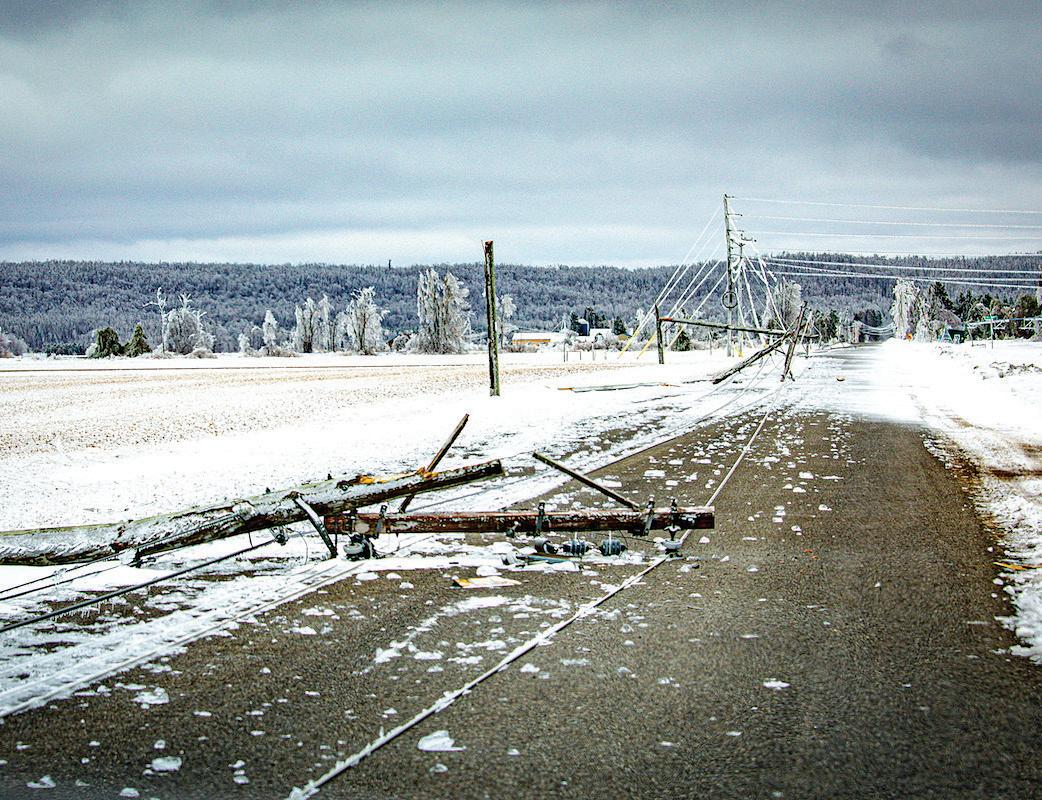
by an outage.
Another technological advancement is the use of artificial intelligence. Fultz said using AI with satellite imaging provides indication of where the largest impact of a storm is likely to be.
It’s all part of living with a new normal. This year alone, there were 29 tornadoes confirmed in the state by June 19, exceeding the total for all of 2022, 2023 or 2024. By late September, the count

reached 33. According to a report from the Rocky Mountain Climate Organization and the Natural Resources Defense Council, the number of extreme storms, defined as those with two inches or more of precipitation in a single day, increased by 42% in northern Michigan and 89% in Michigan from 1964 to 2013.
“We know the weather is getting stronger,” said Fultz. “We’re working together and putting plans in place.”

By Art Bukowski
The Grand Traverse region is no slouch when it comes to high quality, well-respected engineering firms. Several companies in the region continue to tackle an impressive array of projects in northern Michigan and beyond, with many firms boasting clients across the country. Many of these firms are just as involved with protecting northern Michigan’s natural resources as they are with supporting continued growth throughout the region.
The TCBN connected with a few of these companies to see what’s new and what’s next.

Gourdie-Fraser
What recent or current projects are you most proud of?
GFA is privileged to have the opportunity to service many of our northern Michigan communities. So many of our projects are noteworthy, but we’d like to specifically acknowledge some of our park and recreational projects.
There has been significant interest in improving and/or constructing new outdoor facilities in our area. These spaces and amenities promote universally accessible outdoor activities and provide recreation for children, green spaces to relax and locations to host community events. GFA has helped several clients by seeking funding and performing design and construction services to ensure their visions translate into reality. These are projects that can revitalize a community and provide a safe and accessible public space where everyone is welcome.
A few parks and recreational projects of note are the River East Recreation Facility and the Grand Traverse Commons trail in Garfield Township, Railroad Park in Manton, the Betsie Valley Trail in Benzie County, Rotary Park in Elk Rapids and the Ottaway pedestrian bridge for the Grand Traverse Conservation District.

What’s next for your firm?
After more than 75 years of proudly operating in downtown Traverse City, we are thrilled to announce that we have recently moved into our brand-new headquarters located in Garfield Township at 1820 Oak Hollow Dr., just off Park Drive. This exciting move marks a new chapter for our team as we continue to grow and serve our clients. We’re especially enjoying the added conveniences our new location offers, including ample on-site parking for staff and clients along with easy access to the scenic Boardman Lake Loop Trail, perfect for walks and outdoor breaks.
What are the biggest challenges or opportunities in the local engineering scene?
Opportunities ahead include continuing to serve our valued local municipalities, government agencies, private developers and utility companies with high-quality engineering, surveying and inspection services. We also see growing potential in assisting clients with securing funding for critical infrastructure improvement projects throughout the region. Like many firms across northern Michigan, we continue to face challenges in growing local, in-office staffing. It’s a trend that has persisted over the past several years, but we remain optimistic about attracting and developing talented professionals to meet these evolving needs.

What recent or current projects are you most proud of?
Global Environmental is proud to have supported the Michigan Department of Transportation’s Grandview Parkway project in Traverse City, where new deep storm sewer structures required dewatering in areas impacted by BTEX-contaminated groundwater. Our team designed and implemented a comprehensive on-site treatment system to manage the contaminated groundwater, ensuring safe discharge under the project’s [National Pollutant Discharge Elimination System] permit. We also provided hands-on training to Team Elmer’s crews and on-site oversight by a [Department of Environment, Great Lakes, and Energy]-certified wastewater treatment plant operator. The system’s performance allowed construction to stay on schedule while meeting stringent environmental standards. This project showcased our ability to collaborate with local contractors and agencies to deliver practical, compliant groundwater treatment solutions that protect both the community and the environment.
What’s next for your firm?
Global Environmental continues to expand its on-site water treatment
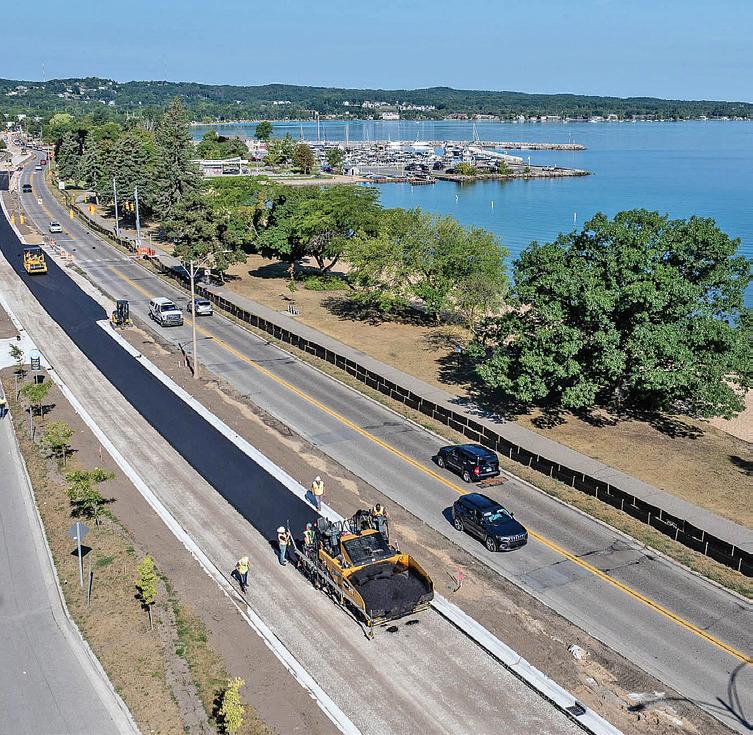
capabilities across Michigan, with a focus on scalable, mobile treatment systems for construction and remediation projects. We’re investing in advanced remote monitoring technology and data-driven system optimization to make field operations more efficient and responsive. As northern Michigan continues to grow, we aim to be the region’s go-to partner for water treatment solutions that support responsible development while safeguarding local water resources.
What are the biggest challenges or opportunities in the local engineering scene?
Northern Michigan’s engineering community faces the dual challenge of supporting rapid infrastructure improvements while protecting the region’s sensitive water resources. Construction projects near lakes, rivers and groundwater demand specialized environmental expertise and strong coordination among contractors, consultants, and regulators. At the same time, this creates tremendous opportunity – firms that can combine technical capability with local knowledge are well-positioned to help communities grow sustainably. For Global Environmental, it’s rewarding to see increasing awareness of the importance of water quality and proactive environmental management in every stage of development.
Otwell Mawby, P.C.
James Jackson, Senior Project Manager
What recent or current projects are you most proud of?
As our area has grown, we have been fortunate to be able to provide our services to a wide variety of clients that include municipalities, schools, conservancies and the development community. While we’re grateful for all of our projects, over the last year we’ve been fortunate to be involved in several high-profile projects in the area that have provided tremendous community benefit, including the Freshwater Research and Innovation Center, the Boardman Building (former TCAPS Administrative Building), the Liv East Bay development, several Grand Traverse Regional Land Conservancy acquisitions including the Elberta Waterfront, the Brown Bridge Quiet Area expansion, among numerous others.
What’s next for your firm?
As a small business that’s been a part of a growing community for over 35 years, Otwell Mawby plans to continue to play a strategic role in assisting clients with ensuring environmental compliance

What recent or current projects are you most proud of?
Traverse City State Park’s improvement project will have a profound impact on the functionality of the campground with the new headquarters building, reconfigured entrance and dump station. We were able to use many of our core disciplines, including topographic surveying, civil site design, wetland delineation, geotechnical soil borings, and now construction observation and staking, which made us especially suited for the project.
We have been involved in the Fish Pass project for almost a decade, beginning with topographic and hydrographic
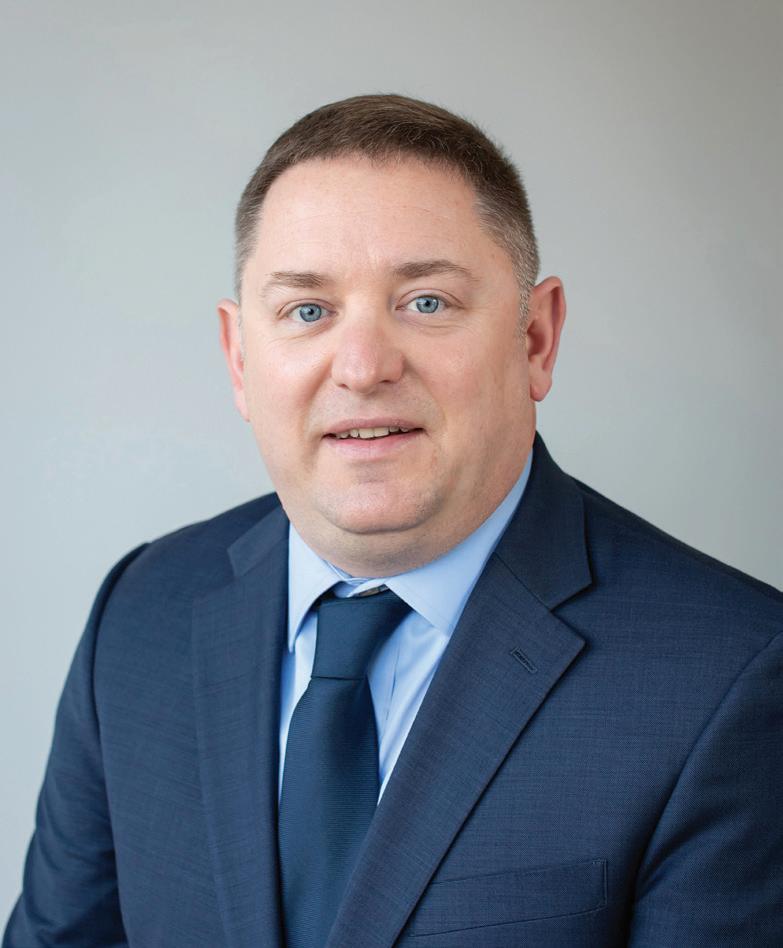
for existing and new businesses and public services and adapting to ever-changing environmental regulations and employing new technologies. We foresee our business growing as expansion in the area continues.
What are the biggest challenges or opportunities in the local engineering scene?
We live in a region that is highly sought after, desirable and attractive to professionals and their families looking for new and better opportunities. Howev -

er, like other area businesses, finding affordable housing for staff is a challenge. We have been fortunate to take an active role in supporting property acquisition and securing financial incentives to add additional affordable housing options

surveys in 2016, so it’s especially rewarding to see the project being completed and also to provide construction staking and settlement monitoring.
Replacing and upgrading Crystal River crossings along County Road 675 near Glen Arbor has been a goal of the Leelanau County Road Commission and Conservation Resource Alliance for years. Working with them on design and construction to improve these crossings to bridges along with stream flow and recreational watercraft movement has been rewarding.
What’s next for your firm?
Gosling Czubak has served public
and private clients throughout Michigan and the Midwest since 1957. We have achieved success and longevity through fulfilling our mission to provide excellent professional services and solutions to our clients in a timely, efficient manner. We strive to be at the forefront of our core disciplines of engineering, surveying, environmental, drilling and construction materials testing. Being one of the few consulting engineering firms in this region that can offer all these services under one roof is key. With nearly 50 professional and technical staff, we have a wide array of skills and talents. Training and mentoring along with equipping staff with the most
to the area. As the region looks to add additional affordable housing options, we look forward to having the opportunity to be a part of these developments while servicing our existing and future client base.
technologically advanced tools such as LiDAR aerial mapping and terrestrial laser scanning is a constant process of continuous improvement. Our people are what’s next and our vision is that each staff member will find passion in their profession, career and project work.
What are the biggest challenges or opportunities in the local engineering scene?
Finding and retaining talented staff is always a great challenge. We have been fortunate to consistently hire exceptional staff across our company. Not only have these been young or graduate employees, but also seasoned professionals that continue to move our company and culture forward.
As we have passed the first quarter of this century, new mindsets and processes are always refreshing. Marrying these ideals with long-standing successful methods can be challenging. This challenge is also a great opportunity. The workplace and methods of work evolve, but providing services and solutions to our clients is always constant. Direct project opportunities continue to come from the infrastructure sector, due diligence services, environmental cleanup and compliance and construction projects. Additionally, the Traverse City area is especially strong in parks, trails and conservancy of the land. Our landscape architecture staff has been instrumental in many of these projects.



melt, in-floor heating, heating, ventilating, air conditioning, interior and exterior lighting, power distribution, fire alarm, and communications systems.
What’s next for your firm?
Traverse City Area Public Schools Sabin Administration addition and renovation: An 8,300 square-foot classroom renovation and a 3,500 square-foot addition to an existing school building to create new administrative offices for TCAPS. Our design scope includes plumbing, heating, ventilating, air conditioning, interior, exterior, and site lighting, power distribution, fire alarm and communications systems.
What recent or current projects are you most proud of?
Traverse City Senior Center: A new 18,000 square-foot facility for the seniors of Traverse City and Grand Traverse County. Our design scope included plumbing, heating, ventilating, air conditioning, geothermal heat exchanger bores and heat pumps, energy recovery, snow melt, interior, exterior, and site lighting, power distribution, fire alarm, communications, and security systems, making the building all-electric building complying with the City of Traverse City’s building electrification policy.
Kalkaska Memorial Health Center’s Acute Care Pavilion and Fixed MRI projects: Construction of a new two-story, 27,230 square-foot acute care addition and fixed MRI renovation for Kalkaska Memorial Health Center. Our design scope included plumbing, medical gas, snow
Traverse City State Park new contact station and new headquarters: A new 559 square-foot contact station and a new 7,650 square-foot headquarters and maintenance building for the Traverse City State Park. Our design scope includes plumbing, sand and oil separation, compressed air, heating, ventilating, air conditioning, gas monitoring, interior, exterior, and site lighting, and power distribution systems, and provisions for a roof-mounted photovoltaic system.
What are the biggest challenges or opportunities in the local engineering scene?
Like other local small businesses, we struggle to recruit and retain employees. We don’t have a tremendous amount of turnover, so we aren’t looking often, but we periodically need to fill an opening, and it can be difficult to find a person with the qualities and skills that we are looking for. We try to prevent this struggle through summer internships or cooperatives for local college students who are trying to understand their engineering options. Other challenges include building and energy code and updates, building construction costs that can push projects over budget and equipment delivery delays that can delay projects.
ventilating, Sarenovarenaddition power communicaand separation, for a opporwe employees. often, openthat understand chalcode budget can
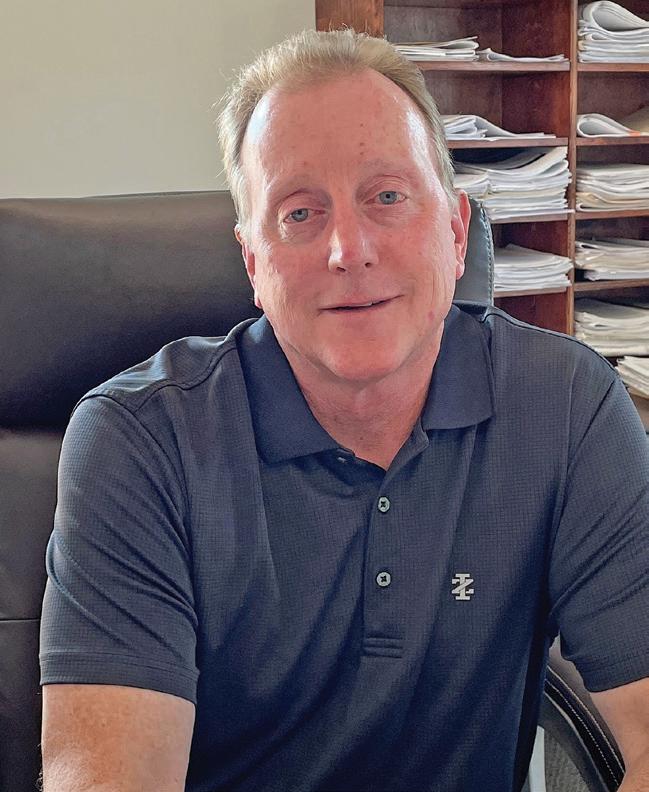

What recent or current projects are you most proud of?
We are proud to have provided structural engineering services for a number of the following local projects: The newly opened Traverse City Senior Center, Immaculate Conception Elementary School, Cathedral Barn at the Historic Barns Park, a new music center at Interlochen Center of the Arts, the Archangel Gabriel Orthodox Church in Williamsburg and the Morgan Farms apartment complex. We have also teamed up to provide the newest additions to many of the local elementary schools.
What’s next for your firm?
We’re involved with a number of exciting projects including Phase II of the YMCA gymnasium addition as well as currently providing structural engineering for the new clubhouse at the Kingsley Club, construction at High Pointe Golf Course and the remodel and addition to the Traverse City Cherry Capital Airport café and gift store. We are currently also working on a number of high-end residences in the residential sector in our area.
What are the biggest challenges or opportunities in the local engineering scene?
Keeping up with the high demand of projects is one of our biggest challenges, and even as a busy engineering company offering great benefits and a dynamic team environment, we are dealing with the labor shortage similar to the rest of the construction industry. Another challenge we have seen is that the higher cost of living makes it difficult to find experienced talent willing to move to the area to keep up with the high demands of growth.
What recent or current projects are you most proud of?
We are most proud of our work on several notable projects, including the Ironton Ferry Landing reconstruction in Ironton, Michigan, the reconstruction of West Bluff Road and retaining walls at the historic Grand Hotel on Mackinac Island, serving as construction engineer for the contractor rebuilding five dams for the Four Lakes Task Force in Gladwin and Midland Counties, acting as reviewing engineer for the Boyne Skybridge and project engineer for high-speed lifts at Boyne Mountain and The Highlands, engineering modular structures for PopStroke facilities in Alabama and Texas and designing foundation systems supporting Battery Energy Storage System (BESS) projects in Colorado, Arizona, New Mexico and Nevada.
What’s next for your firm?
We’re excited about the future as we continue to grow in our key market sectors and expand our services across the country. By adding talented team members and strengthening our existing client relationships, we aim to deliver even greater value while maintaining the high level of support and expertise our clients have come to expect, both locally and nationally.
What are the biggest challenges or opportunities in the local engineering scene?
One of the biggest challenges in the local engineering scene is competing with larger firms for both public and private projects. However, we see this as an opportunity to showcase our firm’s unique strengths. Our specialized expertise, hands-on approach and ability to tackle complex, challenging problems allow us to provide solutions that are unmatched. We focus on delivering quality and innovation, building strong client relationships and leveraging our niche skills to make a meaningful impact in each project.




NMC surveying program named top two-year program in nation
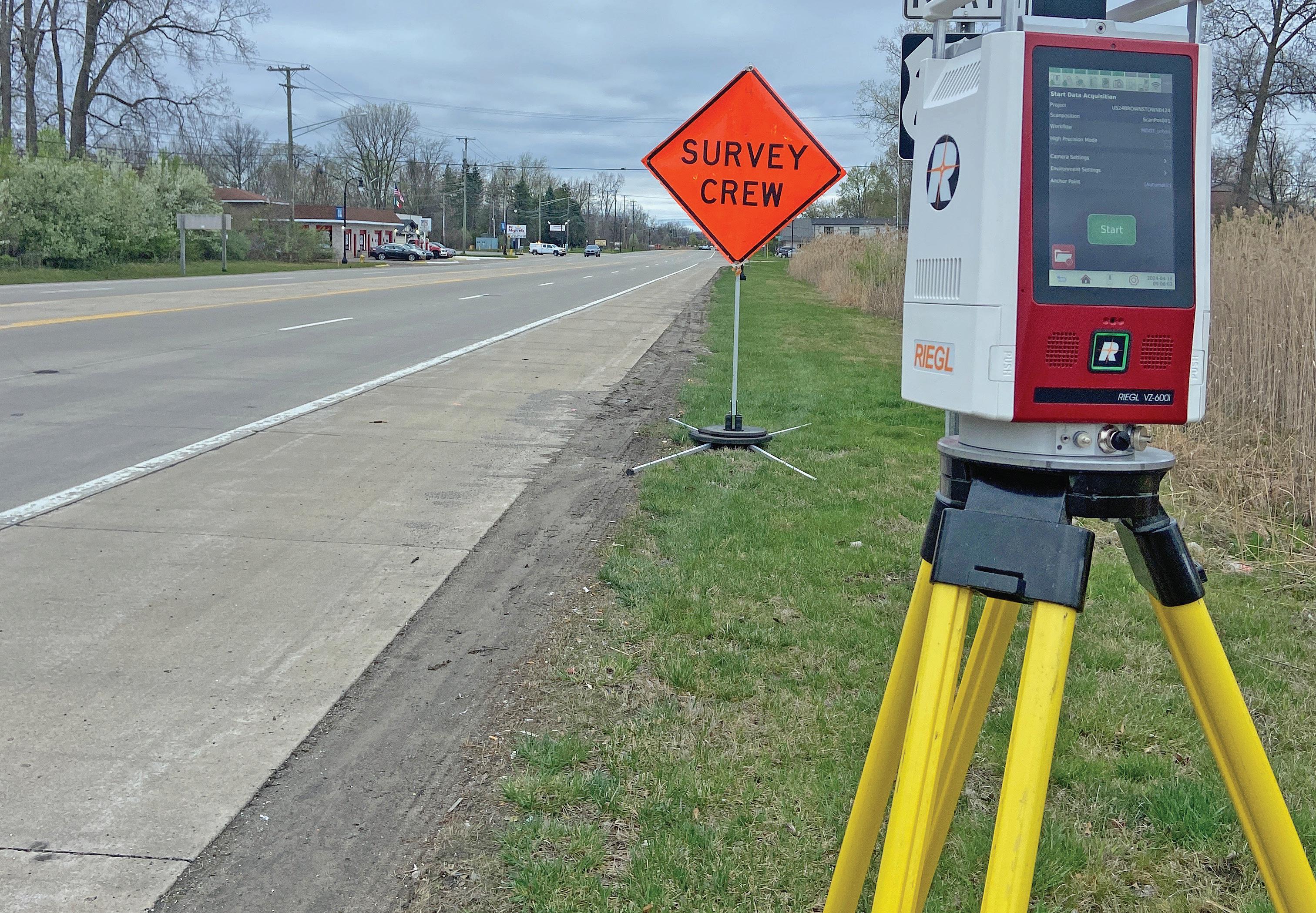
By Ross Boissoneau
Each year, the National Council of Examiners for Engineering and Surveying (NCEES) selects two institutions of higher learning across the U.S. to receive its Surveying Education Award. This year the industry non-profit selected Northwestern Michigan College (NMC) as its $25,000 grand prizewinner in the twoyear program category. The award jury praised the surveying program for being industry-driven and providing a variety of professional pathways to students.
Quite a coup for a program that only came into existence in 2019. In contrast, The Pennsylvania State University, which received the award for four-year institutions, has offered a degree program in surveying since 1957.
The NCEES is an American nonprofit organization dedicated to advancing professional licensure for engineers and surveyors. Jurors considered criteria such as student outcomes and involvement, outreach and recruitment, and the promotion of licensure.
“It is a pretty significant award in the
industry,” said Ryan Deering, who has served as a recruiter for the program since 2021.
He said the college’s unique combination of land, sea and air application provides a great basis for students to pursue further study or professional opportunities. The school utilizes its
Those are the only four-year universities in the state to offer a surveying program.
The students are a mix of recent high school graduates and those seeking additional experience or certification in the field. Instructor Carl Shangraw, who helped formulate the program, says that
“In Michigan, we’re hurting for surveyors. Enrollment is looking good for next year.”
– Ryan Deering, Surveying Recruiter, Northwestern Michigan College
marine tech and uncrewed aerial systems (drone) programs to provide those in the classes with experiences they cannot get elsewhere.
The NCEES recognized that and the fact NMC graduates go on to careers or additional study at four-year programs.
“We send a lot of our students to Michigan Tech and Ferris,” said Deering.
regardless of their age, those in the class are serious about the program.
“It’s a large age range, but they’re focused. They know surveying is what they want to learn,” he said.
Shangraw says the combination of classroom and fieldwork encourages interaction among the students and instructors.
“It’s team-oriented. They’re encouraged to collaborate,” he said. “The older students often act as mentors. They take the younger ones under their wing.”
He says it can also work the other way, with the younger students assisting those who haven’t been in class.
Jim Schiffer and Austin Tripp could be “Exhibit A” in that regard. The two graduates of the program had experience, but while Schiffer runs his own engineering company, Tripp was working as a survey tech for a company in Brighton.
“I was 58 when I started in 2021,” said Schiffer. “The rest were in their 20s and 30s.”
That includes Tripp. He says the connections he made in the program still help him when he has questions.
“Jim and I keep in touch,” he said. Both had experience in surveying previously, and saw the program as a relatively quick way to gain more credentialing. Schiffer is a civil engineer by trade, but had been doing surveying as part of his job.
“I’ve been doing it for 30 years, but
didn’t have certification,” he said. “When I heard about it, it fit.”
By going through the 30 hours of training and passing the licensing exam, he’s now able to advertise his service at The Schiffer Group as both an engineer and a surveyor.
“I learned a lot. I [had] been doing it so long without formal training,” Schiffer said.
Tripp was working as a survey tech for a company in Brighton, and commuted to Traverse City for the classes.
“I wanted the opportunity to advance my career, get an education and go as far as I could,” he said.
He’s since gotten several promotions he said would not have been possible without the certification.
Both of them, as well as Deering, credit the hiring of Shangraw as a key step in gaining credibility for the program.
“It’s great that Carl was there. He’s a really great instructor,” said Schiffer.
Shangraw was a surveying professor at Ferris for 20-plus years until retiring.
“That lasted about three months,” Shangraw said, with a laugh. “I got a call from NMC. They said they were starting a [surveying] program.”
When he was asked if he was interested in teaching, he looked into the possibility. He was aware of the need for more surveying techs as well as those with four-year degrees, and NMC dangled the potential of combining land surveying

with its marine tech program.
“The more they talked, the more interested I became,” he said.
When he then asked what administrative responsibilities he would have in addition to teaching, he was told there wouldn’t be any.
“That was the hook,” he said.
At about the same time Shangraw and NMC were building the program, the state was looking at its licensing requirements. Those who had a four-year degree in a related program could attend 30 hours of classes, which included field work, and then sit for the licensing exam.

That appealed to both Schiffer and Tripp, as they could continue to work in the meantime.
Now Tripp is continuing with his studies, doing online work through the University of Maine.
“It’s pretty apparent in my career that things started changing. I started in a field position, then included office responsibilities. The skills they are teaching [go] from classroom to the workplace,” he said.
That’s deliberate. The program at NMC provides a mix of practical experience and theory.
“The second day of class they’re handson,” said Deering.
Deering and Shangraw are hopeful the recognition will help further boost interest in the program.
“In Michigan, we’re hurting for surveyors. Enrollment is looking good for next year,” said Deering.
Shangraw is even more bullish on the surveying program.
“We should be turning away 10 students for every one [in the program],” he said. “You can get through without debt. The job is fun, good paying and you see the end of the tunnel [with] a two-year timeline.”

Not all back or neck pain is the same. Symptoms like numbness, tingling, or sciatica-like pain may be nerverelated—and now exceptional care is in your own backyard. At Munson Neurosciences, our neuro-spine specialists bring you the latest in treatment options, with the hometown care you deserve.
From consultation to recovery, let our trusted experts treat you close to home, without the long drives, long waits, or compromise in quality.
munsonhealthcare.org/spine to learn more.

By Craig Manning
Could the Great Lakes hold the key to solving the climate crisis, or reversing years of coral reef degradation on the other side of the globe?
Graeme Timmeney thinks the question is worth investigating, and he’s intrigued by the potential that Traverse City has to help answer it.
Timmeney doesn’t live in Traverse City, though he did give a keynote address at August’s “ReShore,” a local event co-hosted by Traverse Connect and MichAuto and intended “to spotlight Northern Michigan’s emerging leadership in blue tech, outdoor recreation, advanced aerial systems, and future mobility.” While Timmeney calls the Grand Rapids area home, though, he’s eyeing Traverse City – and specifically, the new Freshwater Research and Innovation Center – as a valuable ally for the work he does at Blue Carbon International.
Blue Carbon International is “a very small team” of experts in international law, international finance, water, and mapping that partners with countries around the globe to quantify the value of blue carbon resources. Defined by the National Ocean Service as “carbon captured by the world’s ocean and coastal ecosystems,” the term “blue carbon” primarily refers to sea grasses, mangroves, and salt marshes – natural ecosystems within coastal and oceanic environments that capture and hold carbon dioxide.
According to Timmeney, sea grass is “more efficient than rainforests at sequestering carbon,” which makes it a valuable resource for minimizing greenhouse gas emissions and slowing global crises like climate change. Blue Carbon International works with countries “to ensure that the country owns their natural blue carbon assets and that they’re not being sold to someone else, and then we work on figuring out how much those resources are worth” in terms of carbon sequestration.
How does one put a price on something as seemingly prevalent as sea grass?
According to Timmeney, the process involves using satellite imagery, drones, and “some database infrastructure and artificial intelligence” to map and quantify
“The
can hold, in terms of developing a better understanding of our world, I think it’s going to be an invaluable tool for moving ourselves forward and trying to stop some of these seemingly inevitable crises of our planet.”
– Graeme Timmeney, GIS Director, Blue Carbon International
blue carbon resources. Based on that data, Blue Carbon International can calculate “how much CO2 emissions that natural asset is sequestering and keeping out of the atmosphere each year,” a metric that can then be evaluated monetarily.
“Sea grass, mangroves, and salt marshes are the three main things that encompass blue carbon, so we take one of those assets, figure out where they are and how much there is for the entire country, and then determine how much CO2 they are sequestering year after year,” Timmeney said. “We then figure out how much CO2 the country emits annually, and then

that delta [between emissions and sequestration] is monetized under a United Nations Framework.”
Blue Carbon International’s goal, Timmeney says, is to map, evaluate, and monetize blue carbon in a way that is “just and equitable,” so that the country that owns those resources – and the people who live there – are benefitting. Currently, the company’s “flagship projects” are in the Bahamas, though Timmeney notes that Blue Carbon International’s global team is doing work all over, mostly “between the Tropic of Cancer and Tropic of Capricorn.”

The Great Lakes and carbon sequestration
Where Blue Carbon International hasn’t done much work, at least not yet, is in the United States. Timmeney would like to change that. A Michigan man – he got his undergraduate degree in sociology from Western Michigan University, then went back for a master’s in geography –Timmeney has long been fascinated by the Great Lakes. He grew up the son of a divemaster, and he did his master’s thesis on 3D underwater topography. Now, as the geographic information systems director





for Blue Carbon International, he’s curious whether the Great Lakes – and other water bodies in Michigan – could hold their own carbon sequestration value.
“The Great Lakes is where I grew up, and I’ve seen the changes,” Timmeney told the TCBN. “I’ve seen how the quagga mussels and zebra mussels have fundamentally changed the lower tier of the ecosystem, in terms of eating all the small microorganisms and dinoflagellates that the whitefish and walleye used to eat. And at the same time, I’ve seen how the lakes have gotten clearer and clearer – and easier and easier to map.”
Seeing some of those changes has Timmeney wanting to take a closer look at freshwater, even though most of the work his company does is in oceanic settings.
“What I keep saying is: ‘Maybe we should figure out what the Great Lakes is worth [in terms of carbon sequestration] before we go and put a pipeline in,’” he said, referring to the controversial and long-debated tunnel that Canadian energy company Enbridge wants to build under the Mackinac Straits for the Line 5 oil pipeline. “We need to put a value on these resources before they start getting exploited, and definitely before the legislature can pick up and realize, ‘OK, this [pipeline] is damaging our ecosystems, and this is damaging our livelihoods, and this is damaging our fish stock.’”
The Great Lakes are obviously already

valuable on a global scale, given that they encompass 21% of the world’s freshwater, a finite and in-demand resource.
While that value is widely acknowledged, though, Timmeney says the scientific community has little idea whether the Great Lakes also have value in a blue carbon sense.
“Seagrass doesn’t grow in the Great Lakes, but there might be some things going on in deeper areas of the lakes that should be part of our calculations,” he said. “We just don’t know. In terms of
carbon sequestration, research around rainforests started 20 years ago, and research around oceans started 5-10 years ago, but freshwater carbon sequestration has hardly been studied at all.”
Typically, the term “blue carbon” refers to the carbon stored in oceans and coastal marine ecosystems. The term for freshwater carbon sequestration, meanwhile, is “teal carbon,” which can refer to lakes, marshes, rivers, or peatlands. The terminology Timmeney says, was only coined in the past decade, and remains “extremely
“Fine Lake is a lake near me where there’s a massive amount of agricultural runoff, and it’s led to all this algae that makes the lake less desirable for boaters and swimmers,” Timmeney noted as an ENERGY,
underfunded and extremely under-researched.”
Freshwater ecosystems are so under-researched, in fact, that Timmeney says the scientific community doesn’t even know for sure whether something like algae is acting more as a carbon sink or a CO 2 emitter.




example. “But we don’t know whether the algae in the water column, whether it’s sucking in CO2, or, when it dies, if it’s releasing more CO2. We don’t really know.”
Traverse City: Teal carbon capital?
Timmeney is hopeful that, when the new Freshwater Research and Innovation Center in Traverse City opens its doors, it will help draw more attention to the topic of teal carbon and the need to research it.
Already, Timmeney says institutions like Northwestern Michigan College and the Annis Water Research Institute at Grand Valley State University are doing a great job in leading the way on freshwater research and making the Great Lakes region more of a destination for water studies. Not only does he see opportunity for that work to turn into a springboard for more serious research of carbon sequestration in the lakes, but he also sees potential for the Great Lakes to act as a laboratory for players in the oceanic/blue carbon space to develop game-changing technologies.
“It’s the perfect place for the research and development of tools to map the Great Lakes, the ocean, and beyond,” Timmeney said of Traverse City’s new center. “In the Great Lakes, you don’t have the corrosion [from the saltwater], and the lakes are so clear that you have very little risk of running into algae blooms. The Great Lakes are free of all these things that might severely derail research for underwater vehicles or other equipment.”
Mostly, Timmeney sees the need for blue carbon and teal carbon research as an all-hands-on-deck situation, especially in the wake of a recent report from a group called Planetary Guardians.
“That group keeps tabs on seven climate tipping points for our planet, one of which is the health of the coral reefs,” Timmeney explained. “A team of about 160 scientists from around the world all got together and said that coral reefs are essentially past the point of no return. That’s the first tipping point. Well, at the same time, seagrass has been declining, globally, at an alarming rate. I think every
10 years, we’re losing 30% of our sea grass globally. So, we’re at a critical point where we need to make up lost ground. And to do that, we need to know, within very, very narrow error bars, how much sea grass there is globally, where it’s surviving, where it’s dying, why it’s surviving, and why it’s dying, so that we can plan for restoration efforts globally.”
The AI conundrum
Ironically, Timmeney says one of the fastest-growing producers of greenhouse gas emissions could also be key in solving the ocean crisis. Since its popularization several years ago, generative artificial intelligence has rapidly become a climate problem, with proliferating data centers sucking up power and freshwater. Last year, Google reported that its emissions had increased 48% since 2019, attributing much of the increase to data centers.
Timmeney acknowledges the “sometimes incalculable risks associated with AI, whether it’s the environment or data exposure risks,” but says the advantages, particularly for work around blue and teal carbon, could outweigh those risks.
“The benefits that AI can hold, in terms of developing a better understanding of our world, I think it’s going to be an invaluable tool for moving ourselves forward and trying to stop some of these seemingly inevitable crises of our planet,” he said. “I talked about these planetary boundaries we’re crossing. But maybe, with the help of AI, we can solve the coral crisis. We can solve the plastic crisis. We can solve the global warming crisis.”
Already, Timmeney says there are AI tools being made that are geared specifically toward some of these problems. One example is Coral Vita, a Bahamas-based company working on reef restoration. That business, he says, recently designed an AI “that can help plant corals better.”
Another company, called Sway, “is using algae to make plastics, and a lot of their work has been accelerated by AI.”
“So hopefully, AI can inject itself into other industries to help solve any of these environmental risks,” Timmeney said.





















We had KEEN install new lighting in our new office, and the experience was excellent from start to finish. Their team was friendly, communicative, and incredibly efficient throughout the entire process. The installation was completed on time, and we've already seen a noticeable reduction in our electrical costs. KEEN was a pleasure to work with and made everything easy we highly recommend them!
Amanda Risselade Firm Administrator







By Kierstin Gunsberg
Winter is coming, but thanks to solid summer sales, northern Michigan’s outdoor retailers are ready to coast until spring.
It’s a sweet relief given the outlook earlier this year when worries took hold that tariffs and inflation would cut into discretionary spending. That, combined with an 18% dip in travel from Canada – one of northern Michigan’s key seasonal markets – had shops that depend on strong summer numbers kicking off the season with an undercurrent of anxiety. Turns out, people will always dig into their budgets to get to (and spend on) the great outdoors. Outdoor recreation is now a $1.2 trillion industry nationwide, per the Outdoor Recreation Roundtable. Here at home, data from Networks Northwest shows that translates to an economic impact of more than $1 billion annually. Even in Empire, where road construction at the M-72/M-22 junction threatened to put a damper on those 12 make-it-orbreak-it weeks, water-sports shop owner Ella Skrocki says any early concerns that Lake Michigan visitors would be scant this year proved unfounded.
“Our beach was absolutely packed,”
said Skrocki, who runs Sleeping Bear Surf, where sales of paddleboards, kayaks, surfboards and house-branded outerwear ticked up from last summer.
Hot weather brought hotter sales
Hitting the waves wasn’t the only endgame for northern Michigan’s outdoor sports enthusiasts. Pickleball – now a $1.8 billion global market – just logged its fourth straight year as the fastest-growing sport in America. That kept Traverse City’s Dane Fosgard, owner of TC Tennis and Pickleball on Woodmere Avenue, hopping through June, July and August.
“We get about a 40% sales boost during those months,” Fosgard said, noting that despite record-high temps, he still saw a 6% bump in sales over last summer.
Those sweltering days, plus several stretches of wildfire smoke wafting down from our neighbors to the north, may have actually helped his numbers since pickleball and tennis can be moved indoors when the weather isn’t cooperating.
“The indoor facilities help a lot,” Fosgard said. “The tennis programs at the YMCA and the Grand Traverse Resort, they send us a lot of business.”
“The indoor facilities help a lot. The tennis programs at the YMCA and the Grand Traverse Resort, they send us a lot of business.”
– Dane Fosgard, Owner, TC Tennis and Pickleball

The indoor pickleball courts at South YMCA and Pickle-U in Williamsburg do, too.
“We get a lot of their customers as well,” he added.
Another big driver was the shop’s demo program, where customers can check out a tennis racket or pickleball paddle and test
it for a week.
“We lent out 165 tennis racket demos and 100 pickleball demos over the summer,” Fosgard said.
Those demos almost always led to a sale, he says.
“Basically everyone who tries a paddle is pretty much going to buy it,” or at least
“Traverse City is such a big destination that during certain times of the summer, we kind of lose our local customer base because they’re afraid to come downtown. With all the construction and traffic and things like that, they just kind of avoid downtown.”
– Brian Pitser, Owner, The Northern Angler
gets hooked enough to go for a different one, he said.
More families made up festival crowds
Closer to the bay on Front Street, summer tourism doesn’t always translate to more sales for The Northern Angler, the year-round fly-fishing shop that Brian Pitser has run for the past 15 years.
“Traverse City is such a big destination that during certain times of the summer, we kind of lose our local customer base because they’re afraid to come downtown,” he said. “With all the construction

and traffic and things like that, they just kind of avoid downtown.”
This year, though, visitors made up for the crowd-averse locals, and, Pitser says the type of visitor changed, too. He says he saw more families stopping in to make purchases versus the usual in-and-out bachelor and bachelorette groups of summers past — even during National Cherry Festival week, which is usually the “worst” time for his shop, traffic-wise.
“It wasn’t a downward part of our summer. It was pretty steady,” he said.
Besides a small number of pandem-
Running a business is tough enough, you shouldn’t have to worry about your technology. That’s why local businesses trust us as their IT partner.
• Flat-rate IT support (no surprise bills)
• Fast local response times
• Cybersecurity & backup solutions & Cloud & remote work setup

ic-era angler newbies who’ve turned into repeat customers, there are a few surprising demographics which have become more common at the shop this year. Looking for a screen break, Gen Zs have taken up fly fishing, and so have couples seeking a low-key pastime to enjoy together. And as Traverse City’s retiree population shoots upward, so does the number of them coming in to invest in full setups for kids and grandkids.
“[They’re] going out and experiencing these things now that they have the time to do them,” said Pitser, who also runs about 500 guided tours each summer
– roughly 30% of his seasonal business –with the rest coming from retail sales.
“Most of our summer sales are consumable items like flies, leaders and tippets; things that people use to go fish,” he said. E-bike rentals on the rise
Leelanau County’s Nick Wierzba also filled out his summer with a mix of retail and tours at Suttons Bay Bikes. Traverse City hotels, which were in high demand this summer, were a big word-of-mouth driver to his shop. Despite about 5% of tours being canceled due to wildfire


“The e-bike has brought a whole new crowd of people into the sport of cycling. It’s become this equalizer … you’re able to ride at whatever level you can.”
– Nick Wierzba, Owner, Suttons Bay Bikes
smoke, the experience side of his business, which includes rentals, held strong all season long. Meanwhile, the higher cost of everyday expenses “had no impact” on tours and rentals, Wierzba says.
“People are still on vacation,” he said, adding that visitors are willing to spend on the full Up North experience.
“They want to go outside and have fun,” he said.
Retail wasn’t as monumental for Wierzba this summer, though.
“We definitely have seen a kind of more cautious spending behavior from

our retail customers,” Wierzba said.
Part of the problem is that while consumers are waiting on sales to make their big bike and gear purchases, brands are holding back on those sales to balance their already squeezed margins, made worse by tariffs.
“They’re just not offering any deals and promotions. That’s how they’re trying to weather the storm,” he said of his suppliers, adding that he has “missed” those deals and promotions.
“...[T]hose help get people into the door,” he said.
Where retail is dipping, rentals are rising, especially for e-bikes, which averaged 40 checkouts a day at Wierzba’s shop over the summer, a major change from when he first offered e-bike rentals.
“We actually opened the store in 2012 with 10 e-bikes and I can count on two hands the times I rented them. There was very little interest,” he said.
In response to the lackluster, he pulled e-bikes as a rental option until 2017. Then, “it slowly went from like 10% e-bike rentals, which grew heavier … and now it’s somewhere around 65% of our

rentals, maybe more,” he said.
Less than 10 years later, Wierzba says the e-bike has brought a whole new crowd of people into the sport of cycling, because they make it easier for anyone – even those less adept at riding long distances – to hit up the Leelanau Trail or join their family on a wine tour.
“It’s become this equalizer … you’re able to ride at whatever level you can. People see it as a better transportation tool. So, that’s really been the evolution of the past couple years, this summer included,” he said.



Inside Crystal Mountain’s decades-long diversification project
By Craig Manning
“Diversity is key.”
So says John Melcher, CEO of Crystal Mountain Resort in Benzie County, when asked about the ski resort’s business model. Amidst increasingly mild northern Michigan winters, Crystal Mountain’s leadership has made a push to establish the property as “really, a four-season resort, to help inoculate us against difficult weather patterns,” according to Melcher.
As Crystal Mountain approaches its 70th anniversary next year, the TCBN takes a closer look at its evolution – and at how a destination linked with cold temperatures and fresh powder became a hub for everything from golf to mountain biking to real estate.
The early days
Crystal Mountain got its start in 1956, from – of all things – a school project. As the legend goes, Ward Creech, a geography teacher and principal at the nearby Benzonia High School, tasked his students with finding the best spot in Benzie County to establish a ski area. The class settled on a
spot known at the time as the Buck Hills Range, deciding that it “offered the best combination of terrain and snowfall.”
The assignment wasn’t just hypothetical. Soon, the Buck Hills Ski Area had opened, with three downhill ski trails and a tow rope “powered by an old pick-up truck engine.”
has been moving in that direction for decades. According to the Crystal Mountain website, when ownership of the resort consolidated in 1966, the small group of stewards moved forward with a primary goal of making “this winter playground a sustainable year-round business.”
“It has certainly been a deliberate effort to build out year-round activities over the last 30 or so years.”
– John Melcher, CEO, Crystal Mountain Resort
Four years later, in 1960, a group of 96 investors pooled resources to elevate Buck Hills to a commercial venture, complete with a new lodge, dining, a liquor license, 21 guest rooms, a heated pool and a chairlift. To reflect its expansion, Buck Hills also got a new name: Crystal Mountain Resort.
The four seasons
Though Melcher says a recent string of warm, snow-challenged winters has reaffirmed Crystal Mountain’s push to become a four-season resort, the resort
Summer draws in that era included a weekly “Ox Roast,” as well as marching band and basketball camps. There was also nightly dinner theater entertainment from a group of college entertainers dubbed “The Crystalettes.” In the 1970s, Crystal Mountain opened its first golf course, and the summertime aspects of the resort were off to the races.
According to Melcher, longtime Crystal Mountain owners Jim and Chris MacInnes have kept the four-season aspect of the resort near the top of the priorities list for the past 30 years. That emphasis on non-winter
activities has led to two popular 18-hole golf courses, a spa that is regularly ranked as one of the top 100 in the nation by Spas of America, an outdoor water park, a climbing wall, an elevated rope and zipline course, and the only alpine slide in the state of Michigan. The resort is also the venue for “a whole host of other activities in programming throughout the year,” Melcher says, including the Total Archery Challenge, the North Mitten running races, the Michigan Women’s Golf Open and the Peak2Peak Mountain Bike Classic.
“It has certainly been a deliberate effort to build out year-round activities over the last 30 or so years,” Melcher said.
Many of the above attractions have come online since 2000, including the launch of the water park in 2004, the introduction of the “Crystal Coaster” alpine slide in 2008, and a rebuild and reintroduction of the slide – now with a two-track design – just last year.
It’s not just recreation that is driving the year-round business, either.
“Another important component of this strategy is our 32,000-square-foot meeting and conference space, the Crystal Center,” Melcher noted. “We host different conferences and meeting groups there,
and do a lot of wedding and private parties throughout the year.”
While Melcher declines to share what percentage of the resort’s business still comes from ski season, he says that all the diversification has helped stabilize Crystal Mountain to the point where a substantial amount of its traffic now comes during the non-winter months.
“We probably have 350,000 to 400,000 people that visit us on an annual basis, and that would include skiers, golfers, hotel guests, conference groups and people showing up for our events,” Melcher said. “Obviously, in winter, we can host more people here, because we’ve got more room on the ski slopes to have skiers and guests. We’ve got a more limited number that we can put on our golf courses. But I will say, an event like the Total Archery Challenge, where we’ll have the day skier parking lots full, that really draws a lot of people, too.”
Thanks to climate change, winter in northern Michigan ain’t what it used to be – at least not on a consistent basis. While last winter brought significant snowfall and cold temperatures, it came on the heels of the warmest winter in northern Michigan history – a winter that saw 73-degree temperatures in February and full-season snowfall numbers that were dozens of inches lower than average.
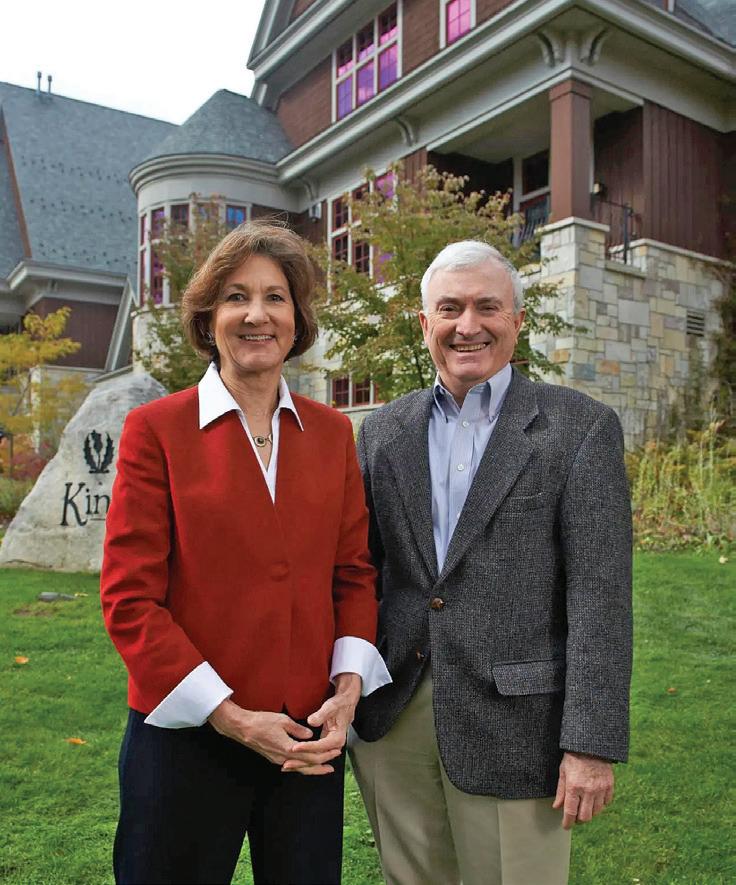
That winter ended with 42 Michigan counties getting federal drought declarations, opening the door for local ski areas like Mt. Holiday to apply for Economic Injury Disaster Loans.
“Mitigating that weather risk has certainly been a priority the last couple of years,” Melcher acknowledged, not just in terms of “building out more non-winter activities,” but also in shoring up the resort’s snowmaking capabilities – and ramping up marketing to let people know that, even in the bad winters, Crystal Mountain has ski-ready slopes.
“Two years ago, when we had that really bad winter, one of our key campaigns was just saying, ‘We have snow,’ and letting



people know what our snow depths were,” Melcher said.
While Melcher is hoping for another good winter in 2025-26, he says Crystal Mountain is ready for anything. In addition to new improvements to the resort’s snowmaking systems, Crystal Mountain is also making a push this winter to establish one of its core summertime activities as a year-round opportunity.
“We’ve been looking at golf simulator technology for some time, and now we’re
– or even just enjoy a round of golf with family and friends – all winter long. Alternatively, for folks that might be going on a winter trip down south, it’s a great opportunity to get a lesson in before they head to Florida or wherever they may be going.”
“If you look at the growth of golf right now, certainly there’s on-course growth, but there’s also been a huge growth with Top Golf and what I’ll call ‘entertainment golf,’” Melcher added.











Despite the declining reliability of northern Michigan winters, Melcher is optimistic about the future of Crystal Mountain.
In recent years, he says, Crystal Mountain has seen an uptick in traffic thanks to “the increased interest in outdoor activities that we saw during the pandemic,” including new skiers, new golfers and new mountain bikers finding their way to the resort for the first time. Helping that trend, he thinks, is northern Michigan’s growing tourism machinery.
“We’re part of a group in the summertime called ‘America’s Summer Golf Capital,’ where the golf properties up here in northern Michigan band together and work on getting the word out to the southern part of the United States,” Melcher said. “If you’re in Texas in the middle of July or August, it’s probably not a great experience playing golf with the heat down there. We’re doing a lot of targeted outreach to those folks down there to bring them here. And certainly, with all the growth happening at Cherry Capital Airport, and all the new direct flights that we now have to Traverse, there’s a pretty good pipeline to get those people here, too.”
First Tracks will replace the building that houses the Mountain Operations Center.
That bullish outlook is reflected in Crystal Mountain’s future plans, including the resort’s latest expansion. That project, called “The North Village,” officially broke ground in October. In addition to adding new residential cottages to the property, the North Village will be anchored by “First Tracks,” described in Crystal Mountain materials as “a slopeside, skier-focused mixed-use building.” The main level will include commercial elements such as a snow sports school, equipment rental, a retail component, and a food and beverage component. The upper two floors, Melcher says, will be “luxury residential.”
First Tracks will replace the building that currently houses Crystal Mountain’s “Mountain Operations Center,” which serves as the hub for snowmaking, grooming and upkeep operations. Those capacities will be relocated to a new space, also part of the North Village development.
Part resort, part real estate company
Leading the charge on the North Village project is Crystal Properties, Crystal Mountain’s in-house real estate development company. Crystal Properties also houses Crystal Mountain Realty, a full-service real estate agency. Together, those two elements constitute a whole other arm of Crystal Mountain Resort that Melcher says often goes overlooked by resort visitors.
“One thing that a lot of folks don’t realize is that we look at ourselves as community,” Melcher explained. “We’ve got four different neighborhoods within the boundaries of the resort, where there are single-family houses throughout. We’ve got a lot of residents that have retired up here and now live here year-round, or maybe it’s a second home. And then, with the advent of remote work over the last few years, we’ve seen people move up here full time, even though they’re still employed somewhere else. So, we’ve got all these thriving residential neighborhoods around the resort.”
Melcher estimates that Crystal has 500 housing units on property, spanning more than 700 property owners, with some condominiums that are fractionally owned in quarter or eighth shares. About 260 units, meanwhile, are in a rental management program, which Crystal Mountain spearheads.
“So, when you come to stay at Crystal, most of our lodging is owned by others, and we manage that,” Melcher said. “That is something that people don’t typically think of when they think of coming to the resort.”

“If you’re in Texas in the middle of July or August, it’s probably not a great experience playing golf with the heat down there. We’re doing a lot of targeted outreach to those folks down there to bring them here.”
– John Melcher, CEO, Crystal Mountain Resort
With so many irons in the fire at Crystal Mountain, and so much focus on the future, what’s the resort’s succession plan?
Chris MacInnes, who serves as president for both Crystal Properties and Crystal Enterprises, the company that operates the resort, has been with the resort since 1985. The daughter of longtime owners George and Althea Petritz, MacInnes moved back to Michigan from southern California to join the family business. Her husband, Jim MacInnes, came with her, and is currently chairman of the resort’s board.
The Petritz/MacInnes family has been involved at Crystal since its beginning, and has been the lone owner since 1981. According to the resort’s website, in 1981 sole ownership of Crystal Mountain came down to a “ ... coin flip between George Petritz and Robert Meyer. The winner would make the first offer, leaving it to
the other to accept or counter. Mr. Petritz won the toss, made an offer which Mr. Meyer accepted.”
Despite that lengthy tenure, the MacInneses have stepped back from dayto-day leadership roles in recent years. Melcher was hired in 2017 to succeed Chris MacInnes as chief operating officer, and then moved into the CEO role in 2021 when Jim MacInnes stepped back from day-to-day operations after 36 years in resort operations.
“As far as succession planning goes, that’s one of the reasons that that I’m here,” Melcher said. “They’ve got me, and also Karyn Thorr, who is our chief operating officer, to focus on the day-to-day. But the family is still very engaged in in the business, and their vision for the mountain continues to be building a thriving community that serves families – and that includes our guests, our employees, the homeowners and the whole region.”

Mt. Holiday’s new leader on current upgrades and the big projects ahead of it
By Art Bukowski
Chris Remy is the new director of operations at Mt. Holiday, a beloved community ski hill on the east side of town. He joins Seanan Culloty as the new director of food and beverage. Together they replace the functions and duties of former Executive Director Jim Pearson, who relocated this year to Grand Rapids.
The TCBN caught up with Remy to see what’s on his mind as he steps into this role – and what’s next for Mt. Holiday.
Tell us about your professional background.
I’ve spent most of my career blending hospitality and the outdoors, from managing bike trails and ski races to keeping a mountain resort running yearround. Before Mt. Holiday, I spent over a decade at Crystal Mountain helping grow their recreation and event programs. As director of operations at Mt. Holiday, I get to do a little bit of everything: Running lifts in winter, events and weddings in the summer and everything in between. My favorite thing is being out on the hill with guests and keeping them smiling, no matter the season.
What is Mt. Holiday doing really well right now?
Reengaging with our community and starting to develop a vision for the future. We’ve built a really strong executive leadership team, and I’m super stoked to get to work with the people I do. I feel like we’re really coming from a place of openness and honesty about the work ahead.
the things that we’ll need to keep this gem going strong into the future.
What are the biggest challenges facing Mt. Holiday?
Infrastructure, and we have some seriously big projects ahead of us. We’re currently upgrading on-hill lighting and our outdated bathrooms. Next is our on-hill infrastructure, lifts and
“Mt. Holiday isn’t just a hill, it’s a gathering place that brings people together, builds confidence in young athletes and keeps the spirit of northern Michigan’s mountain culture alive.”
– Chris Remy, Director of Operations, Mt. Holiday
What does Mt. Holiday need to improve upon?
Communication. We’ve haven’t been great at sharing our story or asking for the things we need from the community. Mt. Holiday has such great history. I love this history and it should be a bigger part of our story. We also need to speak up about
terrain. After that, we’ll start addressing the lodge. So, we’re looking at several multi-million-dollar projects spread over the next five to 10 years while still righting the ship and becoming financially solvent. Such big fundraising lifts will likely necessitate multiple capital campaigns.
What are immediate priorities for the upcoming season?
I wanted to ensure we had some tangible deliverables so the public could see our genuine commitment to making changes, so I wanted to focus on a few projects that I felt were straightforward and easy to accomplish. One of these projects is remodeling and updating our downstairs bathrooms. They haven’t been touched in ages. We’re still in the fundraising phase for the bathrooms, but I’m confident that we can deliver before the winter season begins.
Another project that was important to me was the installation of lighting on the west side of the hill. This area hasn’t had proper lighting in a long time, and now that we have the yellow chairlift up and running after many years, I want to maximize its potential. To achieve this, we’re installing all new LED lighting. This project is now getting underway, and we have the light poles, lights and wiring on property. Our mountain operations team and engineer are working with our friends from 45th Property & Power to get the project rolling in the next few weeks. Guests will then be able to ski and board arguably some of the best terrain at Mt. Holiday both day and night.

What new ideas for opportunities or programs would you like to see implemented?
We’ve been working on our mission and vision, and really it’s about getting back to what Mt. Holiday has always been about: community, keeping things affordable and being a resource for Traverse City. So many people grew up learning to ski and board here, and we want to bring that sense of belonging and connection back to the mountain.
We’ve got some really exciting plans ahead, including new ski programs and opportunities for at-risk youth. This winter, we’re really leaning into lessons and programming – getting more people on the snow and involved in the mountain. As the season goes on, we’ll roll out our plan for improvements across the hill, from lift infrastructure and trail design to snowmaking. From there, our focus will shift to the lodge and what we can do to bring it up to the same standard.
It’s important for us to have a clear
three, five and 10-year plan so we can keep moving forward, stay true to our mission and secure Mt. Holiday’s place in Traverse City’s future. It takes both vision and execution to make all of this happen, and we’ve got an incredible executive team in place. I truly believe we’ve got the right crew to carry this forward.
Why is Mt. Holiday important to the community?
Mt. Holiday is a cornerstone of the community, offering year-round outdoor recreation and a place for families to connect, learn and play. As a nonprofit ski hill, it provides affordable access to skiing, snowboarding, biking and adventure activities for kids and adults alike. Beyond recreation, it creates jobs, supports local events and fosters a love for the outdoors that strengthens community bonds. Mt. Holiday isn’t just a hill, it’s a gathering place that brings people together, builds confidence in young athletes and keeps the spirit of northern Michigan’s mountain culture alive.
History: Mt. Holiday was formed in 1949 when a group of local businessmen obtained permission to construct a ski run on state-owned land. The area was created using volunteers, prison labor, services and donations. In 1985, the area was purchased by Warren Brosch and his wife Sue. The Brosches added two chairlifts, a tube run and a terrain park. After Warren’s death in 1999, Sue Brosch placed the area up for sale. In response to the concern that the area would be sold and developed, a volunteer group formed Mt. Holiday, Inc., a nonprofit corporation to purchase the area. The group set a goal to raise $1.5 million to acquire the area, refurbish it and open it to the public.
Staff: 20-40, depending on season
Visits: About 5,000 skier and snowboarder visits and 2,000 tube visits per season
Annual budget: Around $900,000-$1 million

Originally hailing from Portland, Oregon, Toby Conachan joined Bay View Flooring & Design Center after a decade in high-end retail fashion and custom suiting. He brings a strong background in sales, elevated design, and exceptional customer service. We sat down with Toby to hear his perspective on design, flooring, and life in Northern Michigan—including downtime spent with his 11-year-old red-nose pitbull, Cassius.
“I enjoy the complicated nature of the flooring industry—it’s like a puzzle with ever-changing pieces that require constant adaptation. I landed in this industry due to the chaos of the pandemic and found a strong footing with an amazing company after moving to the NoMi area. Blueprints, country air, Cassius my dog, and Magic: The Gathering have become my newfound peace.”
TOP RECOMMENDATION
“As a technology enthusiast, my favorite flooring is Coretec’s Soft Step. Its 100% recycled underlayment delivers 70% better sound absorption and 40% more warmth than other LVPs, adding a strong green factor to the full package. Plus, Blonde Oak and Sand Dollar Oak are stunning visuals to boot!”
"As a project manager, obstacles and hurdles are par for the course. I am proud to have recently completed a home remodel for a client managing his family property from halfway across the globe in Australia. This distance required us to overcome several key challenges, including navigating communication time differences, creating mock-ups and using room visualizers, and effectively explaining true material colors beyond the altered screen perspective."
“Competition keeps the flooring market dynamic, and Canopy Floors is raising the bar with some exciting new products. These offerings combine durability, style, and innovation, giving customers more options than ever to create the perfect space. I’m really excited to share these products in the showroom and help clients find solutions that meet both their design vision and practical needs.”
“Rome was not built in a day. Careful planning of the project and budget is key— especially in a busy area like Grand Traverse. Being prepared for potential delays or backorders makes the process smoother and more enjoyable for everyone.”


By Art Bukowski
Yes, you can be sure to find the best guns, accessories and supplies at Fieldsport in Traverse City. Wall-to-wall and floor-to-ceiling, it’s one of the best-stocked specialty hunting shops in the Midwest.
But Fieldsport’s reputation rests on much more than the items it sells. Wing shooters (those who hunt various birds on the fly) or those who engage in related sports like clay target shooting have long flocked to Fieldsport for the best instruction and support when it comes to using all this equipment.
Founder and owner Bryan Bilinski – a published wing shooting author and avid devotee of all things shotgun – wouldn’t have it any other way.
“What this store does is sell recreation. I tell my staff, ‘We’re not selling widgets here. We’re not selling just guns or brush pants. We’re selling recreation,’” he said. “And to enjoy it, you want to do it competently.’”
Customers come from across the country and around the world to learn from Bilinski and his staff, who offer lessons, custom gun fittings and more.
“I’m proud to say we’re high on the list [for]… anything that revolves around their search for perfection,” Bilinski said.
Fieldsport hit 30 years in business this year. The TCBN sat down with Bilinski to learn how he got here and what’s next.
An angel named Al
Bilinski, 70, is an Indiana native who spent time managing Orvis operations in Houston before working for an outdoor sports publishing company in Wisconsin. He and a partner decided to open their own publishing company in Traverse City in 1986, and he opted to stay put when that company later relocated to Ohio.
Bilinksi then decided to follow a dream of opening his own store. He wrote a business plan that – through a friend – ended up in the hands of car dealership titan Al Serra. Serra, whose base of operations was in the Flint area, eventually invested $400,000 in the store.
“I owe him my life. It would not have been possible without him,” Bilinski said. “I went to all of those banks back then, and they’d look at you like you were a Martian. They didn’t want to loan money.”
Serra sent some people up to check in on and assist Bilinski in those early days, but he mostly let Bilinski do his thing.
“The beauty of him is … he lets young

entrepreneurs get their wheels going, get started. They can move along to a certain point, and then he comes and says, ‘You can buy me out now,’” Bilinski said. “And I did … probably about 10 years later.”
The store initially carried fishing gear, but Bilinski later dropped it and devoted himself to serving the wing shooting niche entirely. Fieldsport outgrew its first location on South Airport Road and moved to its current storefront in the industrial park at Hammond and LaFranier roads
about 10 years ago.
“I’m very proud of what I’ve produced and of the success it’s had,” Bilinski said. “How many stores in Traverse City, Michigan, started with zero, built from scratch, literally, and are still in business? It’s a very tough town.”
Service is king
Ultimately, customers keep coming back to Fieldsport not just to buy more gear, but
to get better at wing shooting. It’s really no different than other sports, Bilinski says, in that you’re only going to get better with practice and proper instruction.
“If I want to take up golf tomorrow, I wouldn’t just buy some $1,000 clubs and go out and start hitting the ball,” Bilinski said. “I’d get my clubs fitted, I’d go see the best coach in the area and set up enough lessons to start to change my muscle memory as a golfer. And this is exactly the same approach.”
Custom gun fittings mean that the gun’s individual components – stock, barrel, etc. – are tailored so that the firearm is a perfect physical fit for its owner. This is extremely important in wing shooting, where accuracy depends on smooth, precise movements. But even once a gun is fitted, proper coaching is often needed to help correct deficiencies in position and technique.
“When you get to a point where you’re doing it well, it all boils down to muscle memory. You have to repeat, repeat, repeat,” Bilinski said. “But you have to check everything over and get them to the point where all their issues are resolved.”
“What
Bilinski isn’t exactly lacking for customers, but things aren’t like they used to be.
The 1990s through the first part of the next decade were glory days of sorts for outdoor sports, he says, and they don’t appear to be returning any time soon.
“You could not start this business today. The groundswell isn’t there,” Bilinski said. “My old guard – my first customers – they’ve all passed. We’re kind of waiting for the next generation of wing shooter.”
He looks to many high school and college-based shooting programs for hope that the next generation is, in fact, being developed. He also is seeing far more interest in recent years from women shooters, something that used to be comparatively rare.
this store does is sell recreation. I tell my staff, ‘We’re not selling widgets here. We’re not selling just guns or brush pants. We’re selling recreation. And to enjoy it, you want to do it competently.’”
– Brian Bilinski, Founder/Owner, Fieldsport
Howdy Lovey!
Offering services like lessons, gun fittings and more are not only helpful to the customer – they’re a big part of the reason Bilinski is able to stay in business.
“You’re squeezing blood out of a turnip in the gun business because the margins are not great,” he said. “But service is gravy for us. If I take someone out and I give them a private shooting lesson for 400 or 500 bucks, that goes right to the bottom line.”
A lot of these women – and plenty of men – aren’t necessarily interested in shooting to kill. But that’s OK.
“I hear the same story a lot, quite often, and I support it one thousand percent. They say ‘I don’t want to shoot anything.’ And I say you don’t have to. You can go have more fun than you can imagine shooting clay targets with passion,” he said.
Meanwhile, Bilinski has faced intense pressure from the internet for gun sales, yet another reason to lean harder into lessons and service.
Please see Erika’s note from Fierberg Law… Can you make the changes for both Ticker and NE by Thursday at 12 noon? Their next NE ad is next week:).
Those private lessons are also a chance for Bilinski to impart a little wisdom here and there.
“You’ve got to realize what the objective is,” he said. “It’s not to go out and kill a bunch of birds. Sportsmen go through phases, and you eventually evolve to the phase where it’s nice to harvest some birds … but the most important thing is that you should leave the woods and your experience in the outdoors refreshed.”
Talk of service aside, Fieldsport does in fact stock some pretty nice guns that bring people in from far and wide.
“The type of guns we sell, you can’t just buy them down at Sportsman’s Warehouse. What Fieldsport has become is a premium-grade destination gun store,” Bilinski said. “And it’s not money as much as mindset. People who come here are avid bird hunters. They like fine guns, but that doesn’t necessarily mean it’s a $1,000 or $10,000 gun.”

“It used to be you could just stick to MSRP because that’s what everyone did, but now, there’s guys dumping firearms on the market all over the place,” he said. “And people will say ‘Well, can you match their price?’ But it’s below my cost.”
Fieldsport itself has also ramped up its online sales. It’s less personal than Bilinski would prefer, but it’s just what you have to do in the modern environment.
“We’re in a big market now. We sell more guns out the back door than we do the front,” he said. “You can’t wait for the door to swing – those days are over.”
He’s had a hard time keeping staff over the years, as it’s hard to pay career-level salaries in what amounts to retail. He’s hit a good groove in recent years by hiring retirees, who are less demanding and more flexible than younger workers.
Bilinski is slowing down and, at 70, would like to sell the business and retire. He has two daughters who won’t be taking over, so he’s putting the word out that all offers are welcome.
“I’ve loved it, but I have no free time. I have a Labrador that would love to see me take her hunting more often,” he said.
“I come to work every day with the same passion, but how many hours do I have left in my life?”
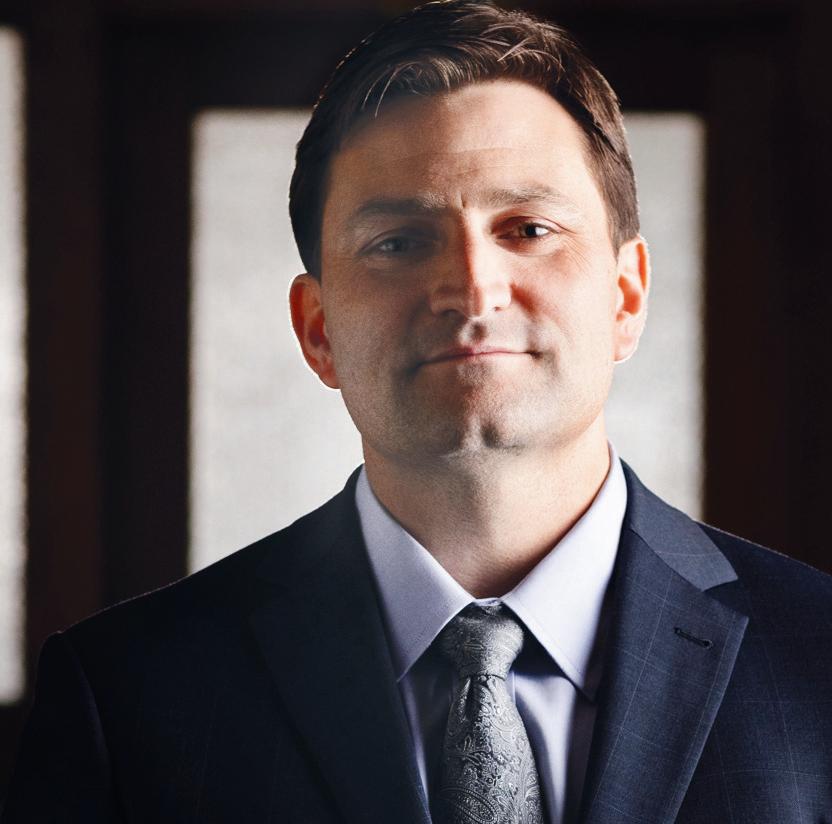

By Craig Manning
Adam Root and Joe Brummitt always knew they wanted to go into business together. They just didn’t know what kind of business – until they found the right fit at a local landscaping company Traverse Outdoor.
Root and Brummitt – a pair of former Michigan State University finance program classmates – acquired Traverse Outdoor last year. Since then, the company had its biggest revenue year in its nearly 50-year history, with technology and process improvements enabling the two to implement company-wide raises, new benefits and profit-sharing.
Now, the duo have acquired a second landscaping company, and are looking to expand into new industries depending on where opportunities arise. On the cusp of all that growth, the TCBN sat down with Root and Brummitt to learn more about where they came from, how they shook things up at Traverse Outdoor and what comes next as they continue to take the Traverse City business community by storm.
Root and Brummitt met at MSU, each earning bachelor’s degrees in finance in the late 2000s (Root graduated in 2010, Brummitt a year earlier). Even back then, the two were envisioning a future as business partners – albeit, without an idea they felt strong enough to make it their raison d’être.
“We actually did some entrepreneurial stuff together in school; we had a startup,” Root said. “But when we graduated, our feeling was, ‘All right, we need to go get real people jobs. We’re not ready to be startup founders yet.’ So, we went our separate ways for a good 10 to 12 years.”
During COVID, Root’s path led to the Kellogg School of Management at Northwestern University for an MBA, where he noticed a trend.
“Entrepreneurship through acquisition was getting more popular, which is kind of like: you want to be an entrepreneur, but you’re not clever enough to have a new thing to start,” Root chuckled.
The concept appealed enough to Root that he made it the thrust of his thesis, which focused on “trying to search and acquire a business up in northern Michigan.” Root is a Traverse City native and an alumnus of West Senior High, where he was a standout on the school’s basketball team, hence the desire to return home.
The thesis project showed enough promise for acquisitions in Traverse City that Root called up Brummitt, in hopes of persuading his old MSU buddy to relocate his family here and rekindle their long-dormant partnership.
Brummitt didn’t need much convincing.
“I had spent a significant amount of time in corporate America, and Adam
and I had always talked about being entrepreneurial,” Brummitt said. “So, the opportunity to work with Adam in this capacity, and to be closer to my family in Michigan, those things were both huge.”
The business partners established an LLC, called Boardman Hannah, and set to work searching for the right business to buy.
“We looked at businesses from software to manufacturing, completely across the spectrum,” Root said. “Our process is we evaluate those businesses on their merits relative to the industry they operate in. And in the green industry, Traverse Outdoor really stood out with the longevity of the business. It opened in 1977, so we’re pushing 50 years at this point, with incredibly high tenure of staff. We have employees that have been with the business for 20, 30, 40 years. For a seasonal business with outdoorsy work, to see that kind of employee retention told us a lot about the business, the founders and the customers.”
On April 1, 2024, Root and Brummitt officially closed on the purchase of Traverse Outdoor.
The learning curve
While Root and Brummitt arrived in Traverse City with significant education and experience in the world of business, there was at least one important thing
they didn’t have: any kind of background in the world of landscaping.
The date of their acquisition meant they were in for a baptism by fire.
“April 1 is, ballpark, the start of the landscaping season here, so we just got absolutely boiled the first year,” Root laughed. “Fortunately, with a team that was so tenured and experienced, we were able to come in and sit and laugh and learn and have conversations, and just dive in without really needing to have a daily operating responsibility that distracted from that. The machine worked, and it was oiled and it was moving, and the jobs were booked. I don’t want to oversimplify and say the business ran itself, but it kind of did.”
The priority, Brummitt says, was simply to resist the urge that many new owners make after an acquisition – that of throwing their weight around too much, too early.
“We didn’t want to come in as two individuals without experience, to a company that’s been operating for four decades, and tell them, ‘Hey, this is how you should do landscaping,’” Brummitt said. “Our goal was to sit and listen. What are the challenges? What are things that are happening that we can offer some expertise in? Where can we make some changes to make things run more smoothly?”
Root and Brummitt waited a year before making any substantial changes

“We didn’t want to come in as two individuals without experience, to a company that’s been operating for four decades, and tell them, ‘Hey, this is how you should do landscaping.’ Our goal was to sit and listen.”
– Joe Brummitt, Co-Owner , Traverse Outdoor
at Traverse Outdoor. Once their 365-day crash course was done, they weren’t cautious about dismantling the parts of the business that weren’t working.
“It was a lot of back-end operations stuff,” Brummitt said of the improvements that landed on his to-do list. “One of the first things we did was we put in a corporate credit card system that is completely linked with our back-end accounting software. That’s not something that the employees would notice a big difference on, because they’re still used to using credit cards. But it is something that gave us a massive advantage in terms of tracking information – tracking spend, tracking location of spend, things of that nature – so that we could see

the data of the business in a much more real-time view.”
Previously, Brummitt says, Traverse Outdoor would print out a credit card statement and then “physically go through and try to match each transaction to an antiquated accounting system.” Now, every swipe of a company credit card triggers an instant notification through Slack – a popular business communications platform – which in turn auto-categorizes that transaction into Traverse Outdoor’s (also new) accounting software.
Root and Brummitt also switched from paper time sheets to a virtual system, implemented new software systems for estimating, scheduling and managing jobs,


and equipped the company’s irrigation team with iPads and a new app for managing client sprinkler systems. Root points to those improvements as major factors behind the company’s record revenues in 2024.
“By cutting out so many manual and paper-driven tasks, we’re literally taking hours out of the day for members of our team,” Root said. “One example is the billing and irrigation service. If we’re





swered, before adding a qualifier. “Just not Root and Brummitt say they’re bullish on Root concluded. “We believe in the growth to outdoors and fresh water. Depending on












The latest TVC news from its Director of Air Service Development

Autumn MacClaren is Cherry Capital Airport’s (relatively) new director of air service development and marketing, and shares with the TCBN the inside scoop on the latest booming growth at TVC, which airline routes are staying and going this winter, and more.
TCBN: Well, we’re used to hearing from [airport director] Kevin [Klein], but delighted to hear from you!
MacClaren: Yes! I started the first week in January, but didn’t move up here until June. I was going back and forth between [here and] downstate the first six months. My job is really fun and changes day-to-day. I work with the airlines on new routes and expanding our awesome existing routes and finding new ways to grow those.
TCBN: I’m guessing you’re basically working with just four to five people –those contacts at each major carrier?
MacClaren: Yes, maintaining those relationships. It’s similar to the role I had at Flint Bishop Airport: gathering the data and telling the story of where our airport needs to go and where we’re headed in terms of our area’s growth and events. It’s an interesting way to dive into the community through that lens.
TCBN: What would be an example of that?
MacClaren: Well, looking at our Dallas route or showing where people are connecting through Chicago or Charlotte. Talking about the big [Traverse City Horse Shows] event here and how the leisure travel demand has grown, but also that our shoulder
seasons have really taken off as our local residents are traveling more in the winter.
TCBN: I know it’s very, very competitive with the airlines, and you’re bringing a better story because we’re growing, versus places in decline. So is, say, Milwaukee aiport’s representative coming in as you’re leaving a meeting at an airline?
MacClaren: It’s hard to even get in front of those people at the airlines. There are literally thousands of airports requesting time with them. So, you’re building relationships, setting yourself apart. Even something as small as sending them Traverse City cherry pie, checking in when you have a new data point or something really cool like a new event happening here.
TCBN: Switching gears, how did our busy summer turn out at the airport?
MacClaren: It was my first summer here. I had heard about it before, but it was pretty wild. Seeing the growth firsthand, we are definitely bursting at the seams. Our new terminal can’t come fast enough. I just loved seeing the team come together and seeing Kevin out there actually throwing bags to make sure we get through this phase before the new addition. It was a very cool thing to witness. We had a lot of weather events, too, which always impact the flight schedule here. But I enjoyed working with the whole team here on all those operational challenges.
TCBN: Do you have the passenger numbers for August? Did you set another record?
MacClaren: Yes. We’ve had 674,088
total passengers January-August, which is up 21.7% versus last year. For August we were up 19% versus last August.
TCBN: How are the airlines doing individually?
MacClaren: United has grown really nicely. Delta has remained steady. American has really grown here. Allegiant is up 35% year-over-year. Sun Country has been steady. Avelo is up. And we added Jet Blue. So really all our carriers are up except Delta and Sun Country, which have been holding steady.
TCBN: How are fall and the holidays looking?
MacClaren: I can’t see future bookings, but I can see seat availability, and the coolest part I think is United is now extended to Denver until December 1, which is a huge extension. It was Jet Blue’s first summer here and they’re now going to Boston through October 23. Charlotte was a year-round route through [a Michigan Department of Transportation] grant. That grant ended, but the season is actually longer than it was prior and now ends November 2 and returns May 1. So more seats in our market overall, which is so important.
TCBN: How about spring break routes and seats?
MacClaren: Allegiant released their schedule and they’ll return in October and go through May 1 and they added seats to their Florida markets, where last year was a record year. Arizona is back, and returns March 19.
TCBN: Is the parking situation fixed now?
MacClaren: Even in September, a traditionally slower travel month, our statistics are showing people out there traveling and our parking lots are still full. So we broke ground on Labor Day on our $3 million economy lot, which will add another 360 spots. That should be ready to go around spring break time.
TCBN: This growth and the need for expansion ... it seemed sort of sudden to many, but I’m sure Kevin saw it building over the years.
MacClaren: He saw it coming, definitely. And now it’s happening and can’t come fast enough. We needed it years ago, really.
TCBN: What’s the update and how will travelers be most affected during the construction?
MacClaren: We will have shovels in the ground in the spring, which is so great. There will definitely be some pains throughout that process, but we have a team here working on a plan during construction to make sure we accommodate travelers. I think the gates and the space in the terminal will be most affected, but as I said, we’re building a plan to minimize how much people are affected.
TCBN: What else is new?
MacClaren: Our new police department [mandated due to airport traffic] is getting up and running, and we’re ahead of schedule on that. Joe Fitzgerald is our new captain, and he’s here and the new station is under construction now [near] the car rental area. There’s lots going on, as always!


Residential construction in Michigan is at a critical point. For builders, one of the most persistent challenges isn’t framing or finishes, it’s utility hookup. Getting water, sewer, gas, electricity and broadband connected to new homes often involves multiple agencies, complex coordination and long waits. These delays add costs, slow projects and limit the number of homes that can come online in an already strained housing market.
The Home Builders Association (HBA) is working to change that. Through advocacy, education, and data-driven programs, the HBA is helping bridge the gap between development and infrastructure, ensuring new homes aren’t held back by red tape.
When builders plan a home, they schedule every phase precisely. But connecting utilities can derail timelines. Builders must coordinate with municipalities for water and sewer taps, with utility providers for service installation, and with inspectors for approvals. If one step stalls, the entire project is delayed.
Across Michigan, these issues are widespread. The Home Builders Association of Michigan (HBAM) and its members have cited power and gas delays lasting months. In Bay County, for example, a workforce housing project waited nearly eight months for water and sewer approvals that should have taken 30 days.
Michigan’s housing shortage – tens of thousands of units below demand – cannot be solved if homes can’t reach occupancy due to utility delays. That’s why HBAM has made infrastructure and utility access a key part of its advocacy agenda.
HBAM has launched four different channels to advocate for more efficient utility approvals.
1. Utility connection advocacy and issue reporting: HBAM has prioritized utility connection reform through its work with the Michigan Public Service Commission and major utility providers, aiming for predictable timelines and accountability statewide. To support this, HBAM created a builder issue reporting form where members can document excessive delays or inspection holdups. Reports are used in policy discussions with state agencies and legislators, turning individual challenges into data that drive measurable improvements.
2. Local advocacy pilot program: HBAM’s Local Grassroots Advocacy Pilot Program, launched in Greater Lansing and Northwest Michigan, empowers local HBAs to work directly with city and county officials on hookup delays, tap-in fees, and inspection procedures. These pilots are creating templates for better statewide cooperation among builders, municipalities, and utilities.
3. Workforce development through the Northwest Michigan Skilled Trades Foundation and Skilled to Build Michigan: While not directly tied to utilities, the Home Builders Association of Northwest Michigan’s nonprofit arm addresses one of the biggest contributors to project delays: workforce shortages. The foundation trains students, veterans, and returning citizens in construction and site-prep trades, including electrical, plumbing, and excavation work, all essential for utility readiness. HBAM’s charitable arm, Skilled to Build Michigan, offers a Residential Construction Skills Certification that equips future tradespeople with the knowledge needed for real-world projects, ensuring the workforce can meet demand and keep housing production on pace.
4. Advocacy on fees and municipal costs: HBAM has a strong record of action when local governments impose excessive or arbitrary utility and tap-in fees. In one case, the association filed a lawsuit against the City of Owosso for raising water and sewer fees without justification. These efforts protect builders, and ultimately homebuyers, from inflated infrastructure costs that make housing less affordable.
Efficient utility hookup isn’t just a builder’s concern; it’s a community issue. Every delayed connection means a home that isn’t built, a family that can’t move in, and a community that loses potential workforce housing and tax revenue. HBAM’s initiatives address these challenges on multiple fronts: advocacy with regulators, local partnerships to streamline processes, workforce programs that ensure qualified professionals and legal action to keep costs in check.
The Home Builders Association of Northwest Michigan is here to help you navigate the process of building your dream home. Our members possess the local expertise and experience to guide you through every step, from initial planning to final construction. Learn more at hbagta.com/.


Our team is committed to building lasting relationships and supporting your health through preventive care and ongoing management. We want the very best for you and your family.




Fueling Michigan today and tomorrow.
Every day, Michiganders depend on secure, reliable energy to heat their homes, fuel businesses, and power industries. Enbridge proudly delivers 55% of the propane used in Michigan.
We continue to modernize our energy infrastructure and further protect the Straits of Mackinac crossing by investing in the Great Lakes Tunnel.
As a North American integrated energy company, we’ve been delivering the energy the state needs for decades and we’re investing in Michigan communities and infrastructure. It’s how we’re building toward a better tomorrow.
Discover more at enbridge.com/Michigan.


Four key considerations could help young adults create a mindset to succeed with saving and investing for the future.
Michelle Wan, Wells Fargo Investment Institute senior wealth investment solutions analyst, has met many younger clients who have had reservations about investing. “Young investors may find themselves delaying investing for retirement because it seems so far in the future. Alternatively, they may enjoy trading volatile investment instruments for rapid profits,” she says. “They don’t realize how important it is to methodically develop planning and investing goals at a young age. Time is a young saver’s greatest ally.” Here, Wan shares four key considerations for young savers when it comes to prioritizing long-term savings and investment plans.
1. Adopt a planning mindset
One key factor is having a planning mindset — a positive and proactive stance that could set savers on a path to positive financial outcomes. A planning mindset can provide a road map that can help strengthen a person’s financial future.
2. Start with small changes
Small changes in your financial behavior today could have a big success. Creating a budget, building healthy financial habits, a fortable and familiar with investing could go a long way in contributing toward achiev ing long-term financial goals.
3. Begin saving and investing now
Start saving for retirement as soon as you can. The sooner you dollar saved has the potential to grow. If dollars saved early in your working years gen erate investment gains year after year, they can have a much bi your account balance at retirement than you might think. Thanks pounding, as the dollars invested potentially earn returns, those reinvested returns can start earning returns, and so on — year after year.
4. Take full advantage of retirement savings plans
If your employer offers a 401(k) plan, be sure to participate — and max out any kind of matching-contribution offers. They are the equivalent of free m Roth IRAs — to which you contribute after-tax dollars — are also worth a closer look because they offer tax-free growth potential. Investment earnings are also distributed tax-free in retirement if specific requirements are met.
A discussion with an investment professional about your investment goals can help you develop a long-term plan and strategies to potentially help you achieve those goals.



















By Jennifer Ewing, columnist
In every workplace, the end-of-the-year holiday season can be a time of tension and emotion.
For some employees, it’s filled with warmth and connection with family and friends. For others, it’s a reminder of loss, a period when traditions don’t match their own, or simply a time when they’d rather work quietly without the extra fanfare. The challenge most organizations face is not whether to celebrate, but how to do so in a way that makes no one feel invisible.
Organizations that want to build an inclusive culture need to consider how celebrations, traditions and expectations affect all employees, not just those who share the same background or beliefs. Many companies plan seasonal parties, gift exchanges or themed activities, but not everyone welcomes these traditions. Some may be grieving the loss of a loved one. Others may practice a religion or cultural tradition that does not align with mainstream celebrations. Being mindful of these realities helps create a workplace where all employees feel respected and supported.
At the same time, there are employees who hold holidays such as Christmas, Thanksgiving or other long-standing traditions close to their hearts. They may worry that efforts to create a more inclusive approach will water down or erase the holidays that matter most to them. It is important that these employees understand that inclusion is not about removing cherished traditions, but rather about making space for more.
A company can still gather for a Thanksgiving meal or decorate for Christmas if those events reflect the values of their employees. What changes is the assumption that those are the only ways to connect. By adding opportunities that are not tied to one tradition, the workplace broadens the circle of inclusion instead of narrowing it.
One way to do this is to rethink the definition of “holiday celebration.”
Instead of focusing on specific holidays,

How companies can build an environment where every employee
companies might offer events centered around appreciation, wellness or community. A winter luncheon, a volunteer opportunity or a wellness day can create space for connection without requiring anyone to celebrate in a specific way. And when holiday-specific events are planned, participation should always be voluntary.
Employees should never feel that not attending will impact how they are perceived or valued at work.
The most effective way to support employees is to ask them directly. Short surveys or informal conversations can help managers understand what people value during this time of year. Some may enjoy opportunities to gather for seasonal celebrations, others may appreciate recognition of diverse traditions, and some might find that flexibility can be particularly meaningful, whether through floating holidays, personal days or adjusted schedules.
Acknowledging a variety of holidays and traditions can strengthen inclusion and this does not mean that every holiday must be formally celebrated. Simple actions, like keeping a shared calendar of observances or avoiding scheduling conflicts can show respect for different
backgrounds. Simple shifts, such as using “Happy Holidays” or “Season’s Greetings” instead of greetings tied to one tradition can help employees feel acknowledged.
At the same time, those who want to express “Merry Christmas” or share their
The challenge most organizations face is not whether to celebrate, but how to do so in a way that makes no one feel invisible.
own traditions should feel comfortable doing so. What matters is that these greetings are genuine expressions of goodwill, not used in a way that distances or excludes colleagues. Respect works in both directions, and balance is what allows
everyone to feel seen.
For those who are grieving, the holiday season may carry extra weight. Employers can show compassion by reminding employees of available resources such as an employee assistance program, encouraging the use of mental health or personal days, or simply checking in to acknowledge their experience. Grief does not follow a fixed timeline. Even years after a loss, this time of year can bring painful reminders. Understanding and patience from managers can make a real difference.
The holiday season can be a time of celebration, but it also highlights differences in belief, culture and personal circumstances. The best workplaces understand that making room for more does not mean losing what already exists. By creating options, honoring cherished traditions, offering flexibility and listening closely, organizations can build an environment where every employee feels welcome and supported during this part of the year.
Jennifer Ewing is part of Human Resource Partners in Traverse City, serving as a fractional CHRO to help employers align people strategies with business goals.






By Kierstin Gunsberg
It’s supposed to be the happiest season, but for 70% of workers surveyed by personal finance brand FinanceBuzz, holiday work parties feel like one more stressor in an already high-pressure Q4.
Of those respondents, 39% said dancing made them uncomfortable, while 46% cited dressing up as a downer. Maybe that’s why this year some of those oldschool formalities are trending down, with employers shelving the default Saturday ballroom soirée in favor of lunch-break snack fests and team-focused activities.
As 2025’s party season commences, here’s what’s gaining popularity – and what’s going by the wayside – for northern Michigan’s holiday party scene.
The post-holiday party is in
For northern Michigan’s hospitality workers, the weeks leading up to December 25 are a marathon of catering gigs, restaurant rushes and retail chaos. But those holiday hustlers want to celebrate too, says Karen Roofe, owner of the indoor plant boutique I’m Planty AF. Her Cass Road shop – which doubles as an off-beat venue for office parties – has seen post-December gatherings surge.
“We’re all busy in December, and so a lot of people do January events to kind of start the new year or cap off the last year,” Roofe said.
She hosted about 25 parties last Jan-
uary, with even more bookings already lining up for this winter.
These after-Christmas parties, which can include hands-on terrarium builds or plant-potting sessions, give teams a chance to relax after a whirlwind month.
“When it’s a bigger company, then we’re usually going to them,” she said, noting she’s set up events everywhere from break rooms to hotel ballrooms. “But if it’s just five or 10 people, it might be easier to come to the shop because then you can make more of a mess. And of course, there’s more options if you’re in the store.”
For the holiday-taxed workforce, she says, there’s an intrinsic calm and reset to spending an evening designing with plants and soil.
“It should be a stress reliever,” said Roofe. “Getting your hands dirty is a good thing.”
Office parties are moving out of the office
No-dress-code celebrations are becoming the norm, says Dorothy Morrison, business manager for K1 Speed in the Cherryland Center. The indoor go-kart facility, which is heading into its second winter season, has become a favorite for teams looking to shake up the workweek doldrums.
“Corporate events are always the best because they’re the most competitive,” said Morrison, whose racing packages start at $60 and include practice times, qualifiers and pole position starts, plus
“They just really want to engage with employees ... They’re not looking to just eat dinner and go.”
– Carolyn Weeks, Co-Owner, The Tasting Room
dining extras that range from pizza to fully catered options.
The high-energy experience typically draws around 20 people per party, though she’s seen everything from eight-person teams to 80-person takeovers.
“We can do a total buyout of the facility and host like 300 if we need to,” Morrison said. “Last holiday season … we were pretty darn busy. We had bookings of about 10 a week.”
This year, requests started rolling in by September. But not everyone’s an adrenaline junkie. For the less speed-inclined, there’s an arcade and restaurant lounge available. Whether it’s on the track or off, Morrison says more employers will forego the typical in-office function in favor of these experience-based parties because getting teams out of their usual surroundings helps create an opportunity for off-

the-clock collaboration that, “comes right back into the workplace when it’s over.”
High food costs aren’t slowing down catering
Even with wholesale food prices up nearly 4% over last year (per the National Restaurant Association), demand for catered holiday parties hasn’t dipped.
Jen Foltz, operations director for Grandview Catering, says that once post-COVID price hikes settled in, clients adjusted.
“They realize that food costs a little bit more and that it costs more to do,” she said. For Grandview, that hasn’t meant much of a dent in business – 80% of their holiday clients are repeats.
“I have a few that like to get on the books toward the end of summer, but really I start pushing Christmas by beginning

of September,” Foltz said. “We have a lot of repeat business. They know what to expect, so that makes it easy for them.”
Grandview’s offering of a $25-per-person buffet, which serves up rolls, dessert, salad, two sides and two entrees is one of their most popular options for those party-planning teams dealing with end-of-year decision fatigue.
“We’ve found that that’s a great tool for a lot of office parties,” said Foltz.
Cocktail luncheons and dinners made up of hors d’oeuvres are another Christmastime hit.
Between full-service catering and platter pickups, Foltz and her team assemble up to 75 holiday events each season which is actually a “very small percentage” of their
overall business, but still a big crunch.
And while end-of-year clients aren’t diminishing, requests for alcohol are as more companies schedule their get-togethers right into the workday.
“We’ve seen a trend the last few years where people [have gotten] away from the big office party with alcohol,” said Foltz.
Small group dinners are going for luxe
Office parties might be veering away from alcohol, but for restaurant venue events, a glass of bubbly is still a must-have for the corporate crowd.
At The Tasting Room off Garland Street in Traverse City, wine selections and craft cocktails are still the norm for


in-house holiday parties.
While they offer a lineup of mocktails for teetotalers, “[i]t is not a huge trend for us,” said owner Carolyn Weeks. “We cultivate our menu on what the customer wants.”
And, proving that bougie bashes aren’t completely out, Weeks has seen a bigger demand for elevated food options, like the kitchen’s five-course pairing menu which currently includes a morel bisque, ahi tuna and a wine selection served with each round.
Those less-casual requests have come as a surprise to Weeks, who joked that analyzing The Tasting Rooms’ offerings against what clients actually want has been a bit of an ego hit. For a while, pizza was a
central menu item for the restaurant.
“That was kind of our thing … we had all these pizzas,” but no one was ordering them, she said. “They wanted the steaks and the seafood. I mean, the amount of seafood that we sell is insane.”
Splurging on an experience that can’t be easily recreated at home makes sense to Weeks. Her corporate holiday clients, whose parties average about 30 people, are looking for a kind of jovial, celebratory camaraderie that allows company leaders a chance to get to know their teams better.
“They just really want to engage with employees, that’s what I’ve kind of noticed,” said Weeks. “They’re not looking to just eat dinner and go.”




By Kierstin Gunsberg
Whether presenting personalized tchotchkes during a breakroom luncheon or sending off loaded baskets to top clients, holiday gifting is a strategic piece of corporate culture, especially when it comes to fostering loyalty. According to a survey by Coresight Research, 41% of participants say gifting has a positive impact on employee retention, while 48% say it improves relationships with both employees and clients.
And as consumable gifts that don’t take up too much permanent space grow more popular, so does sourcing them from northern Michigan-based brands whose lineups feature high-quality products that reflect a distinctly Up North identity – like Benjamin Twigg’s cherry yogurt pretzels or Great Lakes Bath and Body’s beach-inspired soaps.
After 20 years of curating and shipping gift baskets for corporate clients all over the region, Bay Baskets owner Barb Funkhouser says that local products seem to be why a lot of people use her services.
Packed with treats from places like Cherry Republic, Sleeping Bear Farms, Leelanau Roasting Company and Traverse Bay Fruit Company, Funkhouser estimates that up to 75% of her corporate holidays orders are shipped outside the region, sending a taste of northern Michigan across the country.
“December is definitely the biggest month,” she said.
Her offerings are especially popular with doctor and dental practices, Funkhouser notes, adding that she’s seen steady demand even during those holidays where the economy was decidedly less steady, with a slight uptick in requests for larger baskets in the last couple of years.
One thing that has been susceptible to the markets is her supply chain, with tariffs wrenching imports of packaging materials and international products.
“One of my [vendor] companies actually went out of business and was bought by another company,” Funkhouser explained. “I called that other company. I said, ‘You know, can I get some of these things?’”
But as with many aspects of the tariffs, the answer was unclear as suppliers scramble to get ahead of product delays, long lead times and cost surges.
“I’m a little bit worried about getting some containers because many of my things are made in China,” she said.
It’s left Funkhouser tackling logistics right before the holiday rush commences. Representing the brands she puts inside her baskets – and the corporate teams sending them – while making sure those baskets arrive looking top-notch is really important to her.
“I try to have them look nice and give people a good impression, make them feel good about receiving it, make them feel good that someone thought to send them something,” said Funkhouser.
The gift of practical luxury
Traverse City’s Higher Grounds has also been hit by market fluxes this year. But even before tariffs on imports like coffee took effect, climate change had already pushed up global prices.
“Coffee prices were already at the highest they’d been in 60 years or so,” said Lana Lutes, customer success manager at Higher Grounds. But with the global market for specialty coffee expected to grow by 11.8% in the next seven years, the steeper price point hasn’t deterred buyers, she explains.
If anything, it’s upped the appetite for premium, ethically sourced products as a sort of everyday luxury that hits all the right notes for gift-giving, especially with corporate clients.
“Specialty coffee is actually on the rise,” Lutes confirmed.
Lutes says that Higher Grounds hasn’t done much marketing because the gifting program has grown organically through word-of-mouth. The coffee roaster is sending off anywhere from 50 to 500 gift package units per corporate client.
Then there’s the clients hauling out pounds of their best-selling blend, Highland Humanity, to incorporate into their own gift packs.
“Folks also really like to do their own local gift boxes,” said Lutes. “That’s something we’ve been seeing for years.”
On Front Street, Fustini’s Oils and Vinegars – which hit national airwaves in September when they were featured on the “Good Morning America” television show – also caters to clients looking to gift

those everyday luxuries.
“We’re seeing companies look for elevated, consumable gifts that feel thoughtful but practical,” said Ellie Dulude, brand and marketing director for Fustini’s. “Something employees and clients can truly enjoy and use.”
Orders for the Masterpiece Gift Box and the Bread Dipping Gift Box, a seven-piece sampler that includes focaccia bread mix and two signature bottles of oil and vinegar, are already stacking up following the “GMA” shoutout, while their seasonal bestseller, the Herb Pantry Pairing does, too.
“We’ve fulfilled orders over 1,000 boxes for companies in the healthcare and tech space before,” said Dulude, noting that while most of Fustini’s corporate gifting orders come from Michigan, “we’re seeing strong growth in national orders as well.”

That could partly be because food has universal gifting appeal. Everybody needs it, so everybody wants it. Plus, “[y]ou don’t have to worry about size, style or personal preference,” said Dulude, who added that the brand’s bottles of vinegar and oil “bring people together over food, which makes the gift memorable.”
Making a good (and lasting) impression
Giving a memorable gift vs. swag that’ll probably get tossed into the New Year’s
donation bin is one way companies can use the holiday season to build brand awareness. Ida Koivuniemi, founder of Evil Queen Candles, knows that well. Before opening her storefront two years ago in the Warehouse MRKT, she was designing candles for national names like Great Wolf Lodge and Forever 21. Koivuniemi says her non-toxic soy candles, which she describes as having attitude – and which label titles like “Can’t Adult Today” and “Damn, it’s Early” confirm –are “kind of sassy and funny.”
“It was always my goal to make candles

fun gift for people…I think everyone loves candles,” she said.
Especially when, from jar and label to scent, they’re totally customizable for the corporate crowd, which makes up close to 15% of her total business.
“The options are kind of endless there,” said Koivuniemi, adding that her smallest runs start at 10 candles, with price breaks for large quantities.
For organizations whose mission includes philanthropy, gifting local brands that give back add extra value to the gift’s impact. Five dollars from every sale of


while nearly $90,000 in total product sales has supported global environmental initiatives since Koivuniemi launched the company in 2016.
“[We’re] trying to be very eco-conscious, eco-friendly and also give people a great product that they can feel safe and comfortable burning in their home,” she said. “You give someone a candle they really like, they’re going to think of you whenever they smell that candle in the future.”

NOV 7 • 5-7PM



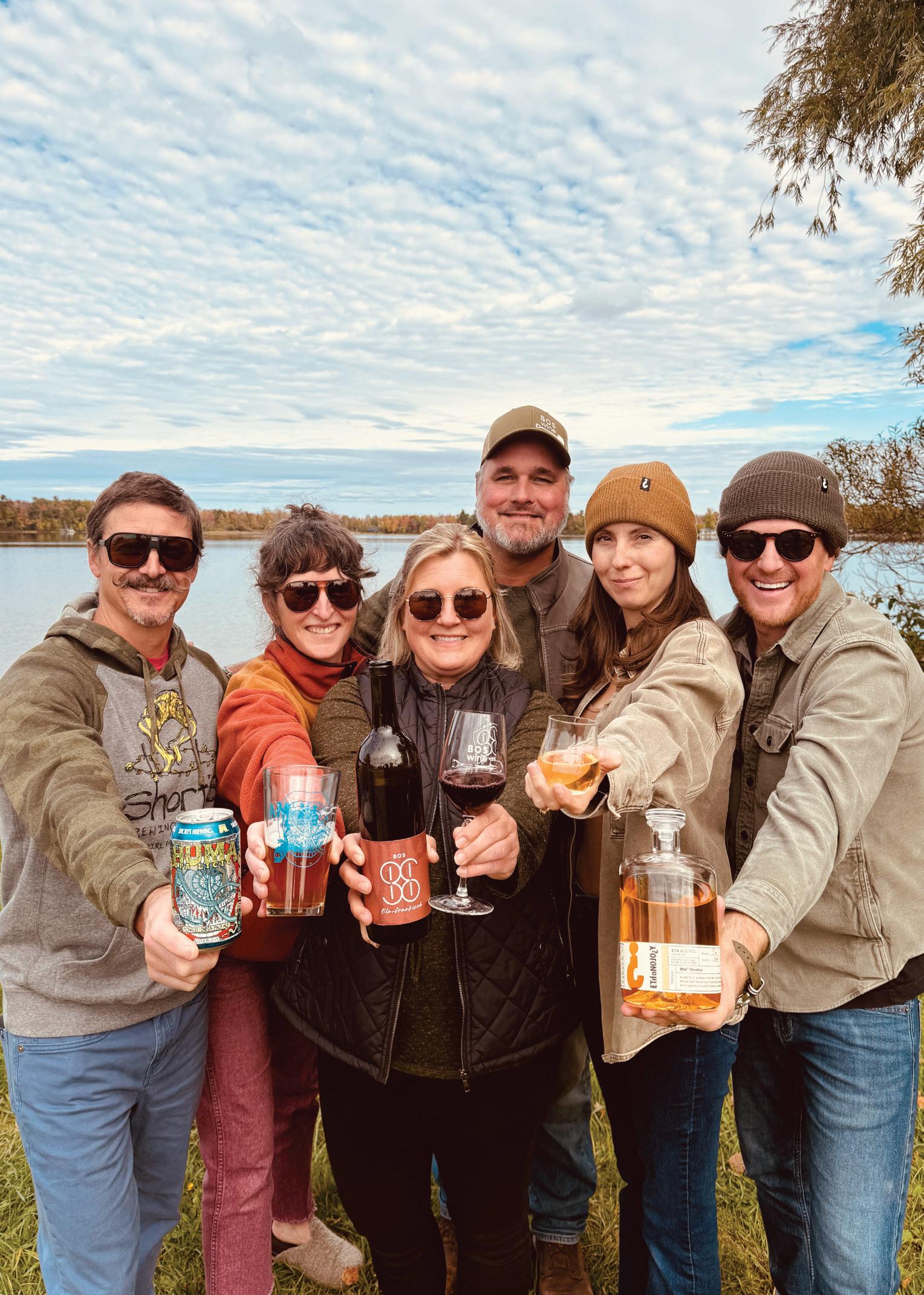
















































By Chris Wendel
“In order for this village community to come alive and really live again in the old way, new people coming in will have to identify with it, with its values, and practical reasons for being a part of it; nostalgia alone won’t do it, and the chill I feel is part of that realization.” –Kathleen Stocking, from her 1990 book “Letters from the Leelanau”
The passage above echoes sentiment that has been heard for decades in our region. Anyone with ties to the Grand Traverse area has felt the impact of its growth over the past few years. The recent pandemic and internet-driven exposure accelerated a population influx. It also put strains on the natural landscape that attracts people here in the first place. Exploring the reasons and ramifications for these changes is the focus of “This Magnetic North” by Tim Mulherin.
Mulherin was first drawn to the Traverse City area in the 1980s by its outdoor beauty and slower pace, which was a welcome contrast to his home in Indianapolis. His earlier book, “Sand, Stars, Wind & Water: Field Notes from Up North,” tempered his love of being Up North with the potential loss of what makes it special. Honing in on the Grand Traverse region, Mulherin defines “Up North” and “Northern Michigan” in “This Magnetic North” as the northwestern portion of Michigan’s lower peninsula.
While promoting the earlier book at a local library, several retail store owners in attendance lamented about the increasing crush and demands of customers during the busy summer season. Around the same time that Mulherin was frequently hearing the terms “pandemic and climate migrants,” related to people able to work virtually from anywhere, choosing to escape to Up North to purchase seasonal or year-round homes. Both of these experiences were the inspiration for “This Magnetic North” that takes on a search for what will ultimately happen to our region.
The book cuts a wide swath with close to 80 interviews with local experts, business owners and notable people from the area, including tribal members, business owners, local law enforcement, tourism experts, farmers and environmental experts.
The theme for each profile follows a pattern, probing into the impact of climate change, the influx of new residents and the inevitable changes taking place. Their responses form a narrative that is intertwined by Mulherin’s own views. “This Magnetic North” shines when he is describing his outdoor experiences related to hiking, birds and fishing, along with the beautiful places he likes to visit. The interviews are wide-ranging and thorough, with the cast of interesting characters we’re

Candid Conversations on a Changing Northern Michigan


introduced to. Mulherin is also an entertaining writer and it was easy to read through the book’s 10 chapters.
If the natural beauty that makes Up North attractive reaches a tipping point with the arrival of people that will ruin it, “This Magnetic North” comes up short on what the future may hold. Mulherin could have dug deeper addressing the plight of residents that struggle to make a year-round living, or younger residents that struggle to find reliable housing and reliable day care. There is also an opportunity to highlight reasons how the region has improved and is much more vibrant than it was 30 to 40 years ago.







Mulhrin throws around the term “tourist” throughout the book, many times in a negative light. Everyone is a tourist at one time or another. When does one stop being a tourist? And when do people who discover a nice place gain the credentials to become annoyed by others who follow the same path?
“This Magnetic North” ends up being a solid almanac for those wanting to become more familiar with the Grand Traverse region and for those already familiar, who want to understand more about its people, history and makeup.
Chris Wendel works for Northern Initiatives, a mission-based lending organization based in Marquette, Michigan. Northern Initiatives provides funding to businesses throughout Michigan and online business resources through its “Initiate” program to organizations and small business owners throughout the United States. Wendel lives and works in Traverse City.






1 - Nick Durga has joined West Shore Bank in Traverse City as a personal banking representative. Most recently, Durga was at Team One Credit Union.
2 - Chad Royal recently joined West Shore Bank as a mortgage lender. Royal has more than 25 years of experience in the title insurance industry, including two decades in the Traverse City community.
3 - Lisa Baldyga, a Jobs for Michigan’s Graduates (JMG) specialist at Networks Northwest in Traverse City, was honored as the October “Specialist of the Month” by JMG. Baldyga serves students at Northwest Education Services Career Tech Center and Northwestern Michigan College.
4 - Michael Long, acting chief judge with the Grand Traverse Band of Ottawa and Chippewa Indians Tribal Court and a local attorney, has been appointed to the Northwest Education Services board as a representative from Leelanau County. Long fills a vacancy left by Jim Scherrer. Long’s term expires June 2027.




5 - Laura Stevens , director of Extended Education and Training a t Northwestern Michigan College, has been named one of the top 20 continuing educators in the country for 2026 by the Learning Resources Network. Stevens is the only individual recognized in Michigan. The recognition is for her pioneering research and work in documenting new financial contributions to the college, including continuing education student alumni donations.
6 - Sarah Lee Sullivan has been named executive director of NAMI Grand Traverse. The National Alliance on Mental Illness works to support individuals and families affected by mental illness. Sullivan brings more than a decade of nonprofit leadership experience to the position. She also serves on the board of Addiction Treatment Services and Generations Ahead.
Munson Healthcare announces the following:
7 - Holly Hinds has joined the Kidney & Hypertension Specialists clinical team. Hinds is a board-certified adult-gerontology acute care nurse practitioner.
8 - Elizabeth Moore , M.D., has joined the family medicine team at Frankfort Medical Group. Dr. Moore has a special interest in full spectrum care for all ages, as well as menopause care.





9 - Cindy Anderson , a Traverse City-based agent with Lake Homes Realty, recently received the Big Wave Award at the company’s National Agent Summit. The award recognizes exceptional achievements in real estate during the last year.
Century 21 Northland announces the following personnel news:
10 - Liz Beck has joined the Traverse City office. Beck has more than 20 years of executive experience.
11- Brian Church recently joined the Traverse City office. Church spent the last 30 years in healthcare administration.
12 - Gerard Henning has joined the Elk Rapids office. Henning brings experience in family business, sales and customer service to his new position.
13 - Associate broker Kate Reichard recently joined the Traverse City office. Reichard has more than a decade of experience and millions in closed sales.




14 - Seanan Culloty is the new director of food and beverage at Traverse City’s Mt. Holiday. Culloty brings two decades of experience in food and hospitality - from fine dining to feeding medical teams overseas - to his new position.
15 - Chris Remy was recently promoted to director of operations at Mt. Holiday in Traverse City. Remy brings more than 20 years of experience in the ski and outdoor recreation industry, including managing seasonal programs and large-scale events, to the role.
16 - Adam Schriber, director of instruction at LochenHeath Golf Club in Williamsburg, was recently named one of Golf Digest’s Top 50 Best Teachers. Schriber was ranked the top instructor in Michigan, and 25th in the country. Schriber has been coaching J.J. Spaun, winner of the 125th U.S. Open Championship this year, since 2022.
Please send Newsmakers by the 10th of the month to news@ tcbusinessnews.com

Munson Hospital surrounded by a variety of Medical Practices. Virtual tour Online –MLS# 1919691 - $1,499,000.



